Feminist Majority Foundation

Winning Title IX Cases
Although many people believe that Title IX applies only to gender discrimination in athletics, the Federal law in fact holds that “no person…shall, on the basis of sex, be excluded from participation in, be denied the benefits or, or be subjected to discrimination under any education program or activity receiving federal financial assistance.” This includes sexual harassment, access to higher education, education for pregnant and parenting students, all content areas from auto repair to zoology, pre K through adult education as well as gender equity in single sex and coeducational environments, testing, career education, employment and technology.
Sections below:
Legal Remedies
Case examples, high school athletics, college athletics, sexual harassment, standardized testing, pregnant students, more information.

So what are individuals’ legal options in the event of a Title IX violation?
- In addition to learning about their rights under the 1975 and the 1106 Title IX Regulations (as well as other applicable federal and state laws) the person considering a Title IX complaint must abide by technical requirements for filing a complaint such as strict time limits and making sure that they have legal status (standing) to complain as a direct or indirect recipient of sex discrimination in an organization that is covered under Title IX.
- The general pattern is to first check out the internal grievance procedures of the particular educational institution that discriminated against them. The Title IX regulation requires that recipient institutions adopt and publish procedures by which individuals may file Title IX grievances. However, the existence of such procedure does not affect your right to file a federal complaint if needed!
- Individuals may file a federal complaint without using existing Title IX grievance procedures . Individuals or groups may even use an online form to file a complaint with the Department of Education’s Office of Civil Rights (OCR) at http://www.ed.gov/about/offices/list/ocr/docs/howto.html?src=rt
- Individuals may file a federal complaint alongside an internal grievance . In this case, the federal complaint must be filed within 60 days of the last act of the institutional grievance process.
- Individuals may file a federal complaint after the unsatisfactory resolution of a grievance by the recipient agency/institution’s grievance procedure. However, in deciding the case, the OCR may choose to defer to the result reached in the internal grievance procedure.
- If neither the internal grievance nor the federal complaint achieved any adequate relief, individuals may choose to file a private lawsuit . Although this is the most costly option, it is the one through which millions have been awarded to some victims of sex discrimination especially if they receive compensatory and/or punitive damages.
Below are various exa mp les of in dividuals who have suffered from gender discrimination in their educational institutions, filed complaints or la wsuits, and obtained some t ype of relief. Some cases have resulted in large monetary awards to the persons who were discrimin ated against or to remedy the situation so that there would not be discrimination against others. Other cases have been settled for smaller or undisclosed sums, typically including a list of remedial provisions. If you or someone you know has been discrimin ated a gainst on account of gender by their educational institution, consider taking s imilar actions against the institution. Remember, you are protected n ot only against the discrimination itself, but also from retaliation, thanks to Jackson v. Birmingham Board of Education (1105). Legal remedies have helped change the system by clarifying the many rights that individuals have under the law. Individuals involved in these complaints have learned a great deal about legal actions and generally helped more people than themselves, but in some cases such as complaints about discrimination in obtaining academic tenure, they found that participation has a high cost in terms of their psychological, time, and financial resources.
Title IX Reaches a Small County in Texas… Susie Halbert’s daughter, a former high school cheerleader in the Kilgore Independent School District in Texas, first noticed that her school’s disciplinary policy discriminated against girls in 1999. She experienced further the same type of discrimination in her school district’s athletic program, when the ISD acted on their preference for the boy’s football team over the female District cheerleaders. After expressing her concerns to her mother, they sought the aid of National Association for Public Interest Law (NAPIL) Fellow and Texas Civil Rights Project (TCRP) attorney Andrea Gunn and decided to file a Title IX lawsuit. They held that the ISD’s actions constituted discrimination on the basis of sex and violated Title IX of the Education Amendments of 1972. The Halberts were awarded $13,000 in the 1101 settlement, which also set up a series of steps for the ISD to follow, aimed at obtaining greater compliance with Title IX. In the end, both Gunn and the Halberts were satisfied and hopeful about the fruits of the settlement, which, according to Gunn, was “a great victory for female participants in extracurricular athletic activities. In particular, Kilgore’s commitment to better informing parents, students, and employees about Title IX grievance procedures, along with increased equity in funding extracurricular athletic activities, sets a wonderful precedent for area schools.” (Reference: Texas Civil Rights Reporter, Fall 1101 )
Angry Father Demands Equity in High School Athletics… Like ‘angry dad’ Russell Johnson of Gadsden, Alabama, 48-year-old father Ron Randolph did not consider himself a feminist and had never heard of Title IX. In fact, he is a registered Republican who does not believe that boys and girls should play together on athletic teams. However, he believes that, “as a question of fairness,” girls should have the same athletic opportunities as boys, and thus he was angered at the blatant sex discrimination that his daughter Mimi’s softball team faced at Owasso High School in Owasso, Oklahoma. As his daughter observed, “Our guys’ team has three sets of uniforms while all of ours total is less than they have in one.” Shortly after, Randolph learned about Title IX in a University of Tulsa seminar taught by a professor with expertise in sports law. After he and other parents asked the Owasso Independent School District to remodel the girl’s softball field, and the ISD declined, they took it to court, filing a lawsuit in 1996 under Title IX. The school district settled with the Randolphs, agreeing to construct a $275,000 state-of-the-art softball facility for girls. The school district had until 1999 to be in full compliance. Randolph notes that it is the school district’s loss; while “they could have gotten out for $35,000 if they had remodeled the field in the first place,” the Owasso school district came out of the settlement paying nearly eight times that cost. Herb Dempsey of Washington State, who too started out as an “angry father,” has filed numerous Title IX OCR complaints targeting unequal athletic facilities. On Randolph ‘s case, he says, “I loved what [ Randolph ] said when he was trying to get a softball field. He said that if he gave 10 dollars of his tax money to the schools and it went for athletics, then five should go to his son and five should go to his daughter. Very simple. Very clean.” This case set a promising precedent. Between 1996 and 1998, seven other Title IX lawsuits already have been filed in other Oklahoma districts. This case set a promising precedent. Between 1996 and 1998, seven other Title IX lawsuits already have been filed in other Oklahoma districts. (References: Women’s Health Magazine, July/August 1106 ; The School Administrator, 1998 ; http://www.athleticsearch.com/bonus6.html )
Three Fresno State Sex Discrimination Cases Yield 0ver $27 million in settlements as of December 1107.
In 1104, after 14 years of coaching the Fresno State University women’s volleyball team, during which she maintained a record of 263 wins and 167 losses and led the team to its all-time highest winning percentage in 1102, Lindy Vivas was fired from her coaching position. Although university officials claim that Vivas failed to meet performance goals and attract crowds at the team’s games, Vivas had evidence that she was discriminated against for trying to implement Title IX. As a leading advocate for equitable resources, marketing and radio and TV coverage for women’s teams, Vivas faced retaliation from her male supervisors in the form of crude and blatant mockery centered on her gender and her perceived homosexual orientation. One afternoon in the spring of 1100, Vivas walked into a department office to find three male administrators reveling in celebration of “Ugly Women’s Athlete Day,” sipping drinks under a banner displaying cutouts of female figures with male heads. After her firing in 1104, Vivas filed a civil lawsuit, alleging discrimination on the basis of her sex and perceived sexual orientation along with retaliation for her efforts to ensure gender equity in athletics. In July 1107, a nearly unanimous jury awarded Vivas $5.85 million in compensatory damages, including past and future economic losses and emotional distress. This was later reduced to $4.52 million . Specifically, the jury ruled that 1) the university acted on the basis of Vivas’s perceived sexual orientation, and 2) the university acted because Vivas was engaged in activity protected under Title IX—the protesting of sex discrimination on behalf of other individuals. In Jackson v. Birmingham Board of Education (1105), the Supreme Court ruled that individuals like Vivas could seek damages for retaliation against their efforts as Title IX whistleblowers. On the verdict, Dina Lassow, Senior Counsel with the National Women’s Law Center, has stated, “I hope it will have two impacts: one in encouraging coaches to speak up if they see discrimination and [secondly] to hopefully make schools think twice about retaliation – and not retaliate, but to respond to the issues and try to make the programs more equitable rather than lashing out against the people who are bringing these things to their attention.” In October 1107, Diane Milutinovich, former associate athletic settled her sex discrimination lawsuit for $3.5 million and in December 1107 Fresno State’s women’s basketball coach Stacy Johnson-Klein was awarded $19.1 million for sex discrimination and retaliation by a unanimous jury.
References: USA Today ( http://www.usatoday.com/sports/college/volleyball/1107-07-09-fresno-state-suit_N.htm?csp=34 ) KFSN TV (ABC Local) ( http://abclocal.go.com/kfsn/story?section=local&id=5465381 ) Fresno Bee ( http://www.fresnobee.com/state_wire/sports_stories/story/81236.html ) Inside Higher Ed ( http://insidehighered.com/news/1107/07/11/fresno ) Fresno Bee ( http://www.fresnobee.com/263/story/251438.html )
Title IX Binds Leading Athletic University…
When place kicker Heather Sue Mercer was cut from the Duke Football team in 1997, she knew that the reason behind the decision was purely discriminatory. Unfortunately for Mercer, the discrimination had begun long before her cut. A highly qualified athlete who had kicked for her New York State champion high school team, she was told by Duke Head Coach Fred Goldsmith to try out for a beauty pageant and to sit in the stands with her boyfriend. Soon after the cut, she filed suit against the university, claiming that the Duke coaches acted on the grounds that she was a female. In treating her differently from male players, she held, the University violated Title IX. Although the Federal law did not force the coaches to allow Mercer to try out for the contact sport, because they chose to do so, they were obligated to treat her as they would male athletes. In 1100, a federal jury ruled in favor of Mercer and awarded her $2 million in punitive damages, as the University had actual knowledge of the Title IX violations and acted with deliberate indifference to them. Mercer plans to use her award to set up a scholarship fund for female place kickers. She stated, “Seven years ago, fewer than 50 women were playing high school football,” she said. “Today, there are more than 800. These women have never had the opportunity to pursue the sport at the next level. It is my hope that this scholarship fund will encourage talented and dedicated young women to achieve their goals. …After years of divisive litigation, we now have the opportunity to do something positive. I invite Duke University to join me in opening doors for female athletes.” (References: Duke University News & Communications, October 20, 1100 ; ESPN interview, anchored by Bob Ley, October 15, 1100 ; Legal Opinion )
Paternalistic and “Unintentional Violation” Defenses Dismissed, Plaintiffs Receive Over $1 Million… For most of the 1990’s, Louisiana State University had neither woman’s soccer nor softball teams. In 1994, three female soccer players, Beth Pederson, Lisa Ollar, and Samantha Clark, and two softball players initiated a lawsuit against the University. However, these women were either pushed aside – as the University contended that there was not enough interest or ability to add the teams, or mocked – when the athletic director called one of the plaintiffs “sweetie,” “honey,” and “cutie,” and said that he would be in favor of adding women’s soccer because “[female soccer players] would look cute running around in their soccer shorts.” It was not until six years later, in 1100, that the 5 th U.S. Circuit Court of Appeals unanimously found LSU to be biased and in possession of a “highly discriminatory” athletics system, and a federal judge ordered both parties to mediate a settlement. When LSU attempted to make a lack-of-interest-and-ability argument, the judge dismissed it as “stereotypical” and “paternalistic.” The University also made the argument that it did not violate the substantive proportionality test of the three-pronged test because such a test could not be used when considering violations of the statute. However, the court found that since the student population at LSU was 49% female, while athletic participation was only 29% female, LSU did fail the proportionality prong. The third argument made by LSU contended that even if it had violated Title IX, any such violation was unintentional. Conversely, the Fifth Circuit held that although LSU may have ignorantly violated Title IX, it “need not have intended to violate Title IX, but need only have intended to treat women differently.” In 1101, a settlement was reached: LSU paid $37,000 to each of four plaintiffs and $1 million to two law firms . In addition to the substantial monetary awards, the settlement required the University to add the two women’s teams and pledge to provide gender equity in facilities and equipment, scholarships, coaching, medical and support stags, travel arrangements, and marketing and publicity opportunities. (References: Sportslaw News, 1101 ; I EXercise My Rights, 1105 ; Marquette University Law School, Volume 2, Issue 4, Spring 1100 )
Lack of Women’s Teams and Funding in Violation, Prompts Promising Compliance Plan…
Until 1995, Virginia Tech had neither a women’s soccer nor women’s lacrosse team. In 1992, concerned female students filed a complaint under Title IX, alleging that the University was not allocating funding and resources equitably between women and men. In 1995, Virginia Tech settled with the plaintiffs for a total of $50,000 , yet denied all of the charges in their complaint. Tech decided to settle due to the high cost of the defense, had the case gone to court. According to President Paul Torgensen, “It is in the best interests of all parties to settle and get on with the more important tasks of expanding sports opportunities for women at Virginia Tech.” In addition to the $50,000, the University added the two women’s teams, upgraded the salaries of women’s sports coaches, improved facilities and increased the total operating budget. In the order issued by the U.S. District Court in Roanoke, both parties settled the complaint based on Women’s Intercollegiate Sports Expansion Plan, under which Tech would recruit and prepare for a 3% increase in participation in women’s sports by the next year, and increase the percentage of financial aid for these women to be in accordance with the overall female share of full-time undergraduate enrollment. (Reference: Virginia Tech Spectrum , 1995 )
Theno’s Anti-Gay Settlement Still Groundbreaking…
When Dylan Theno began his five-year ordeal of sexual harassment in the 7th grade, he must have been assured by his parents that the calls of “fag” and “masturbator boy” would end so long as they maintained a log of the incidents and communicated with school officials – including the junior high and high school principals, the superintendent, and school board members – about the abuse. Despite their efforts, the officials paid little attention to Dylan Theno’s suffering and the abuse persisted until Theno dropped out of school in his junior year. In 1105, at the age of 18 Theno sued the Tonganoxie school district on the grounds that he was denied access to an education, as afforded under Title IX of the Federal Education Act. Theno won a $250,000 settlement, and his attorney, Arthur Benson, praised the District Court’s “groundbreaking” extension of Title IX – typically reserved for sex discrimination in sports – in this case. This reaffirmed the 1999 Supreme Court ruling Davis v. Monroe Country Board of Education , which held that schools may be held liable under Title IX if one of its students sexually harasses a fellow student. While “Title IX traditionally is applied to overt discrimination,” Benson stated that, “this is more subtle. But it is something that is common in our public schools. Kids can be mean to each other. … This verdict should be a warning to all school districts across the country to put them on notice.” (Reference: The Tonganoxie Mirror, August 11, 1105 )
Sexual Graffiti and Crude Gestures Violate Title IX…
15-year-old Katy Lyle was unaware of the sexual graffiti about her displayed in the boy’s bathroom of her high school until her brother saw it and told her in the spring of 1988. The graffiti was bold and explicitly crude, as “Katy Lyle is a slut” constituted the least offensive insult. Despite her mother’s repeated complaints to school officials and their promises to remove it, the sexual graffiti remained on the bathroom walls for nearly two years. Not only did the graffiti stay put, its offensiveness escalated, with accusations of sexual relations between Katy and her brother and references to dogs. The other students’ audacity too intensified; they sent her notes demanding sex, placed obscene drawings on her desk, and yelled expletives directly in her face. The principal refused to take any other measures, later stating that he “felt it would make her a stronger woman.” After her parents visited the principal for the sixteenth time, Katy’s brother took action. In what was one of the first student-on-student sexual harassments cases in the nation in 1989, the Lyles filed a complaint with the Minnesota Department of Human Rights under Title IX. After finding that Lyle was denied the full benefits of an educational experience due to the harassment and inaction, the Commission awarded her a monetary sum of $15,000 . (References: C. Gorny, “Teaching Johnny the Appropriate Way to Flirt.” New York Times Magazine , June 13, 1999, pp. 43-47, 67, 73, 80, 82, 83; Cases & Kinds of Sexual Harrassment, 1992 )
Gender-Biased Handling of Rape Case in Violation …
In October of 1994, former Virginia Tech student Christy Brzonkala was raped by two students in her dorm room. After reporting the rape, college officials turned the case over to a campus judiciary panel, which dropped one of the suspects from charges and found Virginia Tech football player Antonio Morrison guilty of sexual assault in 1995. Morrison was suspended for two semesters. However, after two appeals, college officials decided instead to find him guilty of using abusive language and allowed him to return. Outraged, Brzonkala filed a lawsuit against Virginia Tech under Title IX, contending that the school treated her rape complaint with indifference (1) “to protect the football players” and (2) “because she is a woman.” Both parts of her claim relate to Title IX because of the University’s gender-biased treatment of both Bronzkala and the men’s football team. She also filed her suit under the Violence Against Women Act, and was the first female to do so. Five years later, February of 1100, Virginia Tech settled the Title IX portion of the lawsuit with Brzonkala for $75,000 . (Reference: Sportslaw News, 1100 )
Title IX Applies to Gender-Biased National Merit Examination…
In 1996, the U.S. Department of Education ‘s Office for Civil Rights reached a settlement between FairTest (The National Center for Fair and Open Testing) and the College Board and Educational Testing Service (ETS). Since both the College Board and ETS receive federal funding, they are obligated to follow the Title IX regulations of the Education Amendments of 1972. In its complaint, FairTest, represented by the ACLU Women’s Rights Project, had charged the two organizations with creating a gender biased exam that would be used as the sole criterion to determine National Merit Scholarship semifinalists: the Preliminary SAT/National Merit Scholarship Qualifying Test (PSAT/NMSQT). It held that because males score higher on the exam, they are more likely to obtain National Merit Scholarships; however, although the object of the exam is to predict college achievement, “even the test-makers’ own research admits that the test underpredicts the performance of females and over-predicts the performance of males.” To avoid losing federal funding, both the College Board and ETS had agreed to revise the test in the next year, adding a multiple-choice “writing” component to the exam. Although many argue that this is not a sufficient remedy, the fact that the two organizations agreed, after years of ignoring the requests of women’s and civil rights activists, to reform the exam, shows the power of Title IX. This case further inspired reform of the SAT and GRE, exams that also underpredicted female performance . As a result, millions more dollars in scholarships have been awarded to women. Also a new writing section was added to the SAT, and as expected, the 1106 results showed women scoring higher in writing than men . For more information, go to http://www.fairtest.org . (Reference: FairTest Examiner, Fall 1996 )
Reliance on Standardized Testing for Scholarships Fails Title IX… In 1988, girls won only 43% of Regents Scholarships in New York . At the time, New York State relied solely on SAT scores as the determinant of scholarship recipients, and national results for many years showed males scored consistently higher than females on this standardized test. Taking notice of this fact, New York high school student Khadijah Sharif, along with nine fellow students and two organizational plaintiffs, the Girls Clubs of America and NOW, filed a complaint against the New York State Education Department and the Commissioner of Education, Thomas Sobol. They contended that New York ‘s exclusive reliance on the SAT to award these scholarships discriminated against female students, violating both the equal protection clause of the 14 th Amendment, and Title IX of the Education Amendments. The following year, a federal court ruled in Sharif’s favor, holding that the state of New York could no longer rely solely on SAT to determine Regents scholarship recipients . It found that while white males made up 47% of the scholarship competitors, they received up to 72% of the scholarships. As a remedy, the state added high school grades to the qualifying criteria, and notably, in the following year, girls ended up winning 51% of the scholarships. (References: Sharif v. New York State Education Department (1989) Legal Document ; I EXercise My Rights, 1105 )
Title IX Reaches Pregnant Female Students… 19-year-old Margaret Contreras kept quiet about her pregnancy during the first five months, for fear of experiencing what her older sister had gone through two years prior in the Independent School District of Luling, Texas. After school officials had found out that she was pregnant, they forced her out of school. Despite fears that administrators would kick her out as well, Contreras had hope that she would be able to stay, after hearing that other schools offered services for pregnant students. But after approaching the principal for such services, he told her that not only did the school not offer pregnancy services, but she would have to leave her regular classes. In order to graduate, the only option for Contreras was to take a GED class at night, “so her fellow students wouldn’t see her swelling belly.” In 1101, Contreras and another pregnant student, Celia Leon, filed suit against the Luling ISD, alleging that it had denied them an education – by ordering them to leave school and refusing to provide homebound or other educational services while pregnant. In discriminating based on gender so that it decreased a student’s educational opportunity, the LISD violated Title IX. The next year, the Luling ISD (LISD) Board of Trustees reached a settlement that allowed the girls to re-enroll in school, granted them a monetary award, and provided for many reforms of the LISD’s Pregnancy Related Services (PRS) Program . The girls’ attorney, Andrea Gunn of the Texas Civil Rights Project, stated that “as a result of this lawsuit, pregnant and parenting students in the Luling ISD can finally be ensured they will be provided with equitable educational resources and opportunities. This is a great victory in the struggle against pregnancy discrimination and the egregious effects of such discrimination, including increasing high school drop-out rates.” (References: Texas Civil Rights Project Press Release, August 14, 1102 ; The Texas Observer, 1102 )
“Disparate Impact” Acknowledged in Discrimination Against Pregnant Students’ Membership in the National Honor Society…
When Grant County High School students Somer Chipman Hurston and Chasity Glass were denied membership in the National Honor Society due to their statuses as pregnant mothers, they sought the help of the ACLU, which defended them in their complaint against their Convington, Kentucky school in 1998. They held that it discriminated against them based on gender, violating Title IX, the state and federal Constitutions, and the Kentucky Civil Rights Act. In spite of their pregnant statuses, both Chipman and Glass had top grades and past records of high achievement. Still, they were the only two students eligible for membership to be excluded from the Honor Society induction. While the school argued that they had not based their decision on pregnancy, but on “non-marital sexual relations,” the presiding Judge Bertelsman dismissed this reasoning; while the school district’s policy excluded 100% of young women who had become pregnant from premarital sexual relations, it excluded 0% of young men who had premarital sexual relations. Moreover, it was reported in affidavits submitted to the court that “more than a dozen Grant County High School students who were admitted to NHS testified that no one connected with the society or the school had asked them whether they engaged in non-marital sex.” Foremost, Judge Bertelsman based his decision on the policy’s “disparate impact on young women such as [Chipman and Glass].” Ruling in the girls’ favor, he issued a preliminary injunction ordering the school board to admit them into the honor society for rest of the year, while in wait for the trial. The successful ruling, which held Grant County School District in violation of Title IX, came one year after Title IX’s 25th anniversary, in 1999. (Reference: NewsCenter Press Release, 1998 )
Want to Find Out More? For more information on the Title IX regulations, guidelines in specific areas, the OCR complaint process and other legal settlements, go to the Title IX Defined page on this website and read the PDF of Feminist Majority Foundation intern Jenny Lee’s 1106 paper Title IX Infractions: Legal Options and Winning Cases . If you have a description of another important Title IX case that might be added to these web pages, please send it to [email protected]

Don't miss tomorrow's Higher Education industry news
Let Higher Ed Dive's free newsletter keep you informed, straight from your inbox.

5 college Title IX lawsuits to watch
These recent cases stand to change the way colleges adjudicate the controversial federal sex discrimination law.

It's been two years since U.S. Education Department Secretary Betsy DeVos revoked the Obama administration's guidance directing how colleges should investigate and arbitrate episodes of sexual violence on campus.
Coming in the form of a "Dear Colleague" letter in 2011, the rules were largely credited with giving sexual assault survivors new protections and implied colleges and universities should more aggressively pursue sexual violence on campus. But the guidance was extremely unpopular among civil liberties advocates who believed university officials, under threat of losing federal funding, were pressured to find accused students responsible in these cases.
DeVos' replacement for the Obama administration's guidelines is set to drop soon. Though the Ed Department has provided colleges and universities with interim directives for handling sexual violence, many of the Obama-era procedures remain in place on campuses. And hundreds of lawsuits have been filed since 2011 challenging the fairness of institutions' processes.
This is a trend that will likely continue, said Peter Lake, director of the Center for Excellence in Higher Education Law and Policy at Stetson University. He told Education Dive that "there has been a litigation explosion" on Title IX, the federal law banning sex discrimination, with more novel arguments and theories of liability being attempted.
A Supreme Court battle on many of these issues is looming, Lake said. And it seems unlikely that the lawsuits will cease any time soon.
To examine how these issues are working their way through the courts, we've gathered five Title IX cases that have drawn the attention of lawyers, pundits and administrators this year.

James Haidak v. University of Massachusetts at Amherst
Details of the case: James Haidak is a former University of Massachusetts at Amherst student who was suspended and then expelled after his ex-girlfriend accused him of physical assault while they were studying abroad in 2013. Haidak sued the university, alleging administrators subjected him to a biased hearing process. A federal district court dismissed his claims, but an appellate court found his suspension was likely unconstitutional because he hadn't been given a chance to have a hearing beforehand.
Why it's significant: In the case, the U.S. Court of Appeals for the First Circuit deviated from an opinion issued last year by the Sixth Circuit's appeals court, which presides over Michigan, Ohio, Tennessee and Kentucky. In 2018, the latter wrote that accused students had a right to the cross-examine their accusers in most Title IX proceedings.
The First Circuit agreed, to an extent, that cross-examination should be allowed but maintained that the questions can come from a neutral panel rather than accused students or their proxies. The discrepancies in the court rulings potentially set up a Supreme Court challenge, and may clarify a major issue among Title IX practitioners, experts told Inside Higher Ed .
Where it is now: Remanded to a federal district court for further proceedings.

John Doe v. Boston College
Details of the case: In 2012, John Doe was attending an event on a cruise ship for Boston College's student newspaper. While Doe was crossing a crowded dance floor on the ship's deck, another student was sexually assaulted, turned around and saw him, and assumed he was at fault.
While Doe was arrested, his charges were eventually dismissed after prosecutors reviewed video of the night. But college officials did not wait for the criminal investigation to conclude, and they ultimately found him responsible for the assault. In September, a jury found that he was denied a fair process.
Why it's significant: It is the first sexual assault case to reach a federal jury trial since Obama introduced the 2011 guidance, according to media reports, though it claimed a state "breach of contract" rather than a Title IX violation.
Where it is now: Decided. The jury awarded the student more than $100,000, a far cry from the $3 million he initially sought.

John Doe v. Rhodes College
Details of the case: A former fraternity member and football player sued the college after he was expelled for allegedly raping a female student in February of this year. The student contended that wide news coverage of the incident influenced the college's decision.
Why it's significant: In June, a U.S. district court stopped the college from enforcing the expulsion pending the outcome of the lawsuit. In that order, the judge indicated that the student's due process rights were likely violated.
This may not seem extreme, but Rhodes is a private institution. And the concept of constitutional due process is not usually a factor in cases involving private colleges, according to The National Law Review .
Where it is now: The college settled privately with the plaintiff.

John Doe v. Michigan State University; John Doe v. University of California
Details of the cases: In both cases, only one or two students alleged unfair Title IX processes, but their lawyers are attempting to turn them into class-action lawsuits. In the separate lawsuits, the students allege that their respective institutions didn't let them cross-examine their accusers.
Why they are significant: If either of the lawsuits were to be successful, lawyers estimate they could potentially overturn hundreds of university decisions in sexual violence cases. This would open the door for similar lawsuits to be filed at other major institutions.
Where they are now: Lawyers are waiting for the lawsuits to be certified as class-action.
Gruver v. Louisiana State University
Details of the case: Max Gruver, 18, died in 2017 while pledging a fraternity at Louisiana State. He was ordered to chug hard liquor during a hazing ritual and later died from alcohol poisoning. His passing garnered national attention and increased calls for a crackdown on hazing.
Gruver's parents sued under Title IX , arguing the university had not monitored hazing among the fraternities in the same way it had sororities, putting men at greater risk for injury or death. This, the parents' lawyer contends, is a Title IX violation. In July, a federal judge allowed the case to move forward .
Why it is significant: Never before has Title IX been tested in this realm. It has usually been applied to campus sexual violence or inequities in athletics. Claiming a Title IX violation in a hazing episode opens up the possibility for students to allege administrators have been biased in other areas, such as if men and women were cited for underage drinking disproportionately.
Where it is now: Awaiting trial.
Recommended Reading
Higher Ed Dive news delivered to your inbox
Get the free daily newsletter read by industry experts
- Select user consent: By signing up to receive our newsletter, you agree to our Terms of Use and Privacy Policy . You can unsubscribe at anytime.

Editors' picks
Black students who enroll at HBCUs have higher bachelor’s degree attainment, research finds
But those who initially attended a historically Black college also had higher debt loads than their similarly situated peers, a working paper found.
Colleges that require DEI statements would lose federal funding under House bill
The proposal from Rep. Dan Crenshaw, a Texas Republican, highlights the momentum behind efforts targeting diversity, equity and inclusion.
Keep up with the story. Subscribe to the Higher Ed Dive free daily newsletter
Company Announcements

- 20 senators ask Cardona to delay gainful employment, financial value transparency deadline By Natalie Schwartz
- Brown University reports drop in diversity among incoming students By Laura Spitalniak
- What Kamala Harris’ presidential nomination could mean for HBCUs By Danielle McLean
- University of Iowa employee bilked nearly $1M from campus machine shop, audit finds By Ben Unglesbee
- Global directory Global directory
- Product logins Product logins
- Contact us Contact us
Our Privacy Statement & Cookie Policy
All Thomson Reuters websites use cookies to improve your online experience. They were placed on your computer when you launched this website. You can change your cookie settings through your browser.
- Privacy Statement
- Cookie Policy

Join our community
Sign up for industry-leading insights, updates, and all things AI @ Thomson Reuters.

CoCounsel: The GenAI assistant for legal professionals
Bringing together generative AI, trusted content, and expert insights for a new era of work.
Cut drafting in half
Professional-grade GenAI for drafting right from within Microsoft Word

Build a career without boundaries
Learn more about how Thomson Reuters informs the way forward in The Power of Purpose
Related posts

How to go from summer associate to full-time associate

Noncompete agreement — Legal glossary

Quid pro quo: Meaning, contextual examples with infographic
More answers.

Legal tech buyer’s guide for legal research and other core tasks

How to create a successful employee onboarding process

Why have millions lost Medicaid coverage?

An official website of the United States government, Department of Justice.
Here's how you know
Official websites use .gov A .gov website belongs to an official government organization in the United States.
Secure .gov websites use HTTPS A lock ( Lock A locked padlock ) or https:// means you’ve safely connected to the .gov website. Share sensitive information only on official, secure websites.
A Case Study of K-12 School Employee Sexual Misconduct: Lessons Learned From Title IX Policy Implementation
This case study included a purposeful sample of five geographically and demographically diverse districts that experienced an incident of school employee sexual misconduct in 2014, and lessons are drawn for addressing and preventing such cases through the implementation of the provisions of federal law Title IX.
To prevent offenses of sexual abuse from occurring, school districts are attempting to comply with Title IX, a federal law that provides guidelines for preventing and responding to school employee sexual misconduct in K-12 schools. Title IX requirements for schools encompass comprehensive policies and procedures; prevention efforts; training for staff, students, and parents; timely reporting; thorough and coordinated investigations; and effective response. The purpose of the current study was to examine Title IX policy implementation in school districts that experienced a case of school employee sexual misconduct in 2014. Conducted from January 2016 to September 2017, this study involved 92 participants who contributed data through 41 interviews and 10 focus groups. Information was also obtained from document and policy reviews. Based on the study's findings, the researchers recommend that school districts review their policy and implementation efforts in determining whether they are compliant with the key elements of Title IX guidance. Researchers also recommend that the federal and state departments of education establish accountability measures to track policy implementation and ensure that school districts comply with Title IX guidance and provide high-quality, low-cost training options. A further examination of prevalence data, victim and offender characteristics, effects on victims and school communities, criminal justice responses, and the effectiveness of prevention efforts are also recommended. Participants in the study also offered recommendations for improving a school's prevention and response efforts in countering school employee sexual offenses. 6 tables, 53 references, and appended key elements of Title IX, resource list, study sample. protocols, and Title IX codes
Additional Details
Related topics, similar publications.
- Trajectories of Offending over 9 Years after Youths' First Arrest: What Predicts who Desists and Who Continues to Offend?
- Adolescent Weapon Carrying Inside and Outside of School: The Impact of Experiences and Perceptions of Violence
- Victimized Teachers’ Perceptions of Procedural Justice and the Impact on Satisfaction with School Responses
Featured Topics
Featured series.
A series of random questions answered by Harvard experts.
Explore the Gazette
Read the latest.
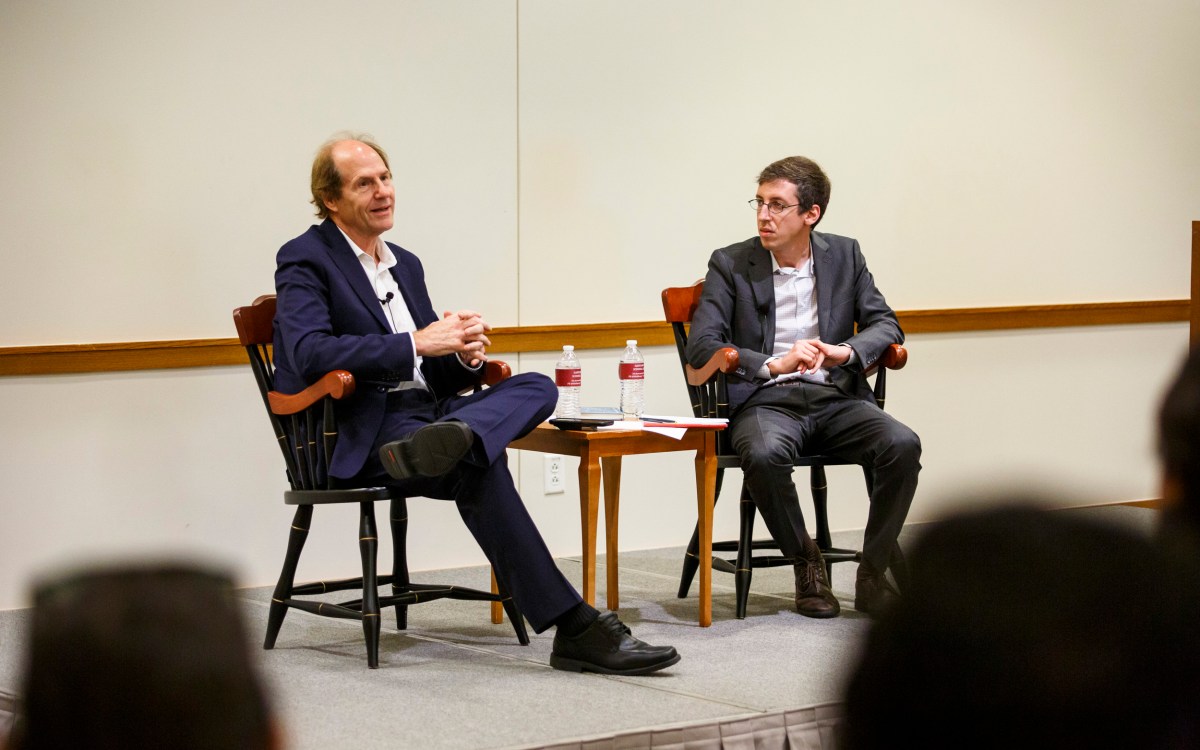
Speech is never totally free

EVs fight warming but are costly. Why aren’t we driving $10,000 Chinese imports?

Toll of QAnon on families of followers
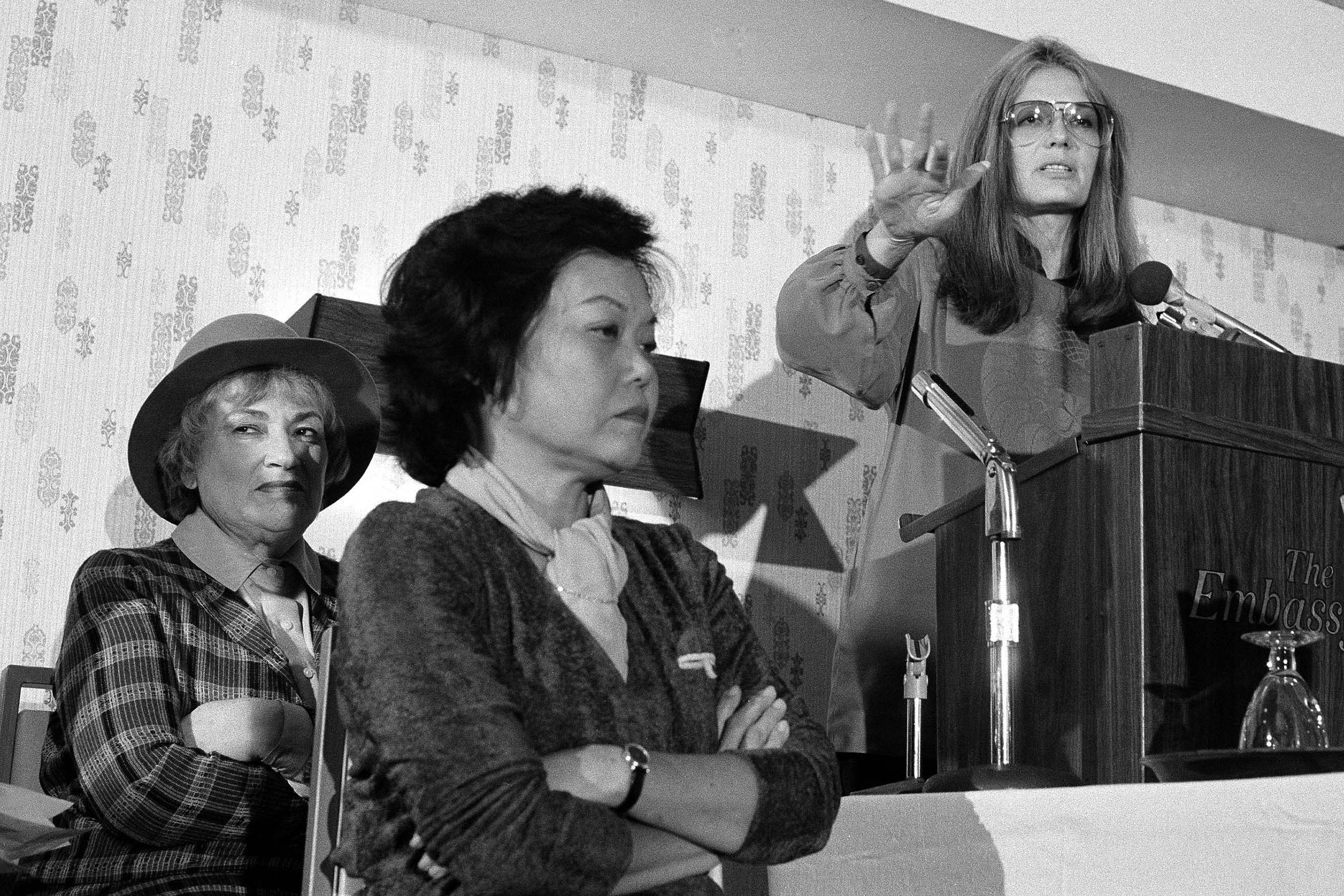
Rep. Patsy Mink (center), the first woman of color elected to the U.S. House, helped push Title IX through Congress. She’s joined at a 1979 press conference by Bella Abzug (left) and Gloria Steinem, other leading figures in the women’s rights movement.
AP File Photo/Harvey Georges
How Title IX transformed colleges, universities over past 50 years
Alvin Powell
Harvard Staff Writer
Upended intercollegiate sports but also touched many corners of campus, forcing shifts in hiring, promotion, admissions, reckoning on sexual harassment, assault
A half century after its enactment, Title IX, the federal law that bars discrimination against women in education, has forced a leveling of the playing field on campus, though advocates say its work is still not done. In recent years, the law has forced a reckoning over sexual harassment and assault on campus, and its protections have been extended to cover bias on the basis of sexual orientation and gender identity. Those impacts follow on others, particularly in women’s sports, where the changes it forced have been described as “transformative.” The Gazette asked Jeannie Suk Gersen, the John H. Watson Jr. Professor of Law and an expert on gender and the law, and Susan Ware, A.M. ’73, Ph.D. ’78, historian and author of “Title IX: A Brief History With Documents” (2014) to discuss the legacy of the law. The two were interviewed separately for this piece, and both interviews were edited for clarity and length.
Jeannie Suk Gersen and Susan Ware
Gazette: Why was Title IX needed when it passed in 1972? Didn’t the Civil Rights Act of 1964 ban discrimination in several areas based on sex?
Gersen: Women faced blatant educational inequality, such as exclusion from certain colleges and universities or from certain programs and spaces within those schools, higher admissions standards than men, more frequent tenure denials than men, and myriad other imposed disadvantages relative to men. Title VII of the Civil Rights Act had prohibited sex discrimination in employment but didn’t cover education, and Title IV had prohibited discrimination in federally funded entities but didn’t cover sex discrimination. So Title IX followed up in 1972 to fill the gap and directly address sex discrimination in education.
More like this

‘You need to take care of your female student athletes’
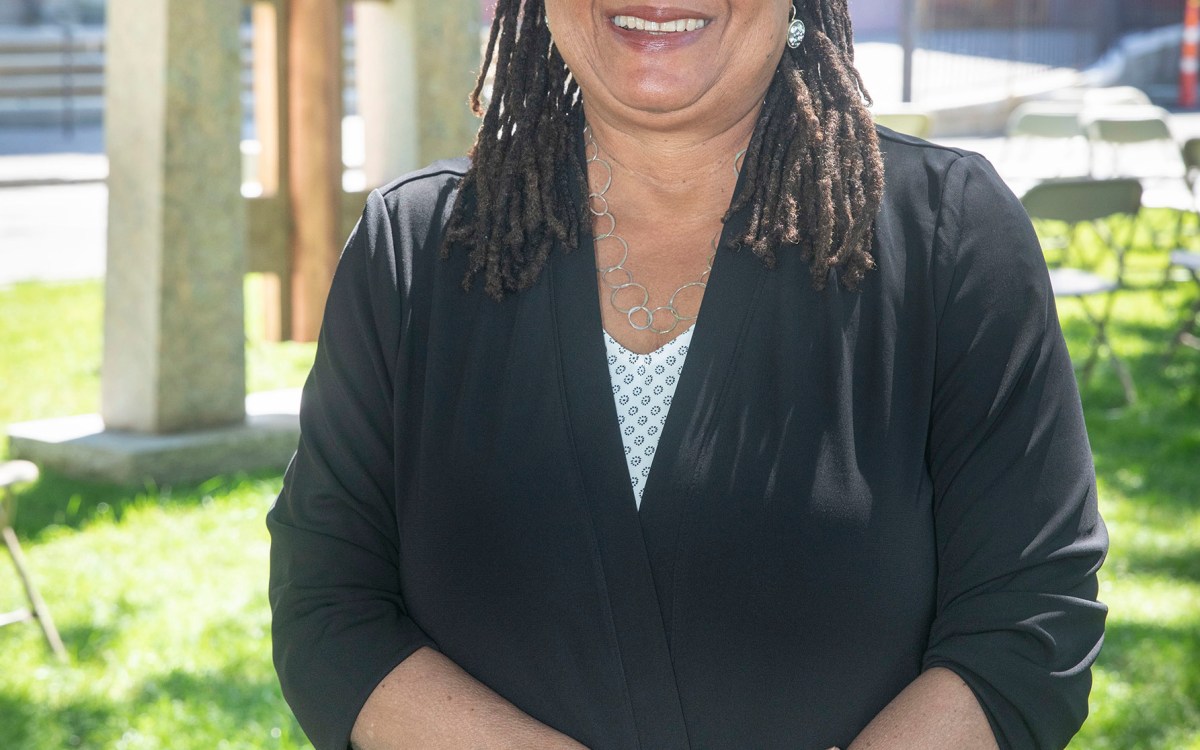
Women in STEM need more than a law
Gazette: Were there fierce partisan battles over the passage of Title IX?
Gersen: Title IX was passed with bipartisan support and was signed into law by President Richard Nixon. But it was wrapped in controversy as part of the wider controversial debate of the era about what equality would mean for women’s traditional roles in the home and in society, exemplified by the fight over the Equal Rights Amendment, which was ultimately not ratified and did not become a constitutional amendment.
Gazette: After 50 years, does it remain controversial?
Gersen: Title IX remains controversial because even as the ideal of equal opportunity and prohibiting sex discrimination are widely accepted as a general matter, what constitutes discrimination on the basis of sex has been fiercely debated. The meaning of “discrimination” and the meaning of “sex” have also become less settled over the decades, particularly as young people on campuses in each generation question what these concepts mean and breathe new and urgent meaning into the promise of Title IX. These debates keep the interpretations of Title IX controversial, even among people who have no trouble agreeing that sex discrimination in education is prohibited and unacceptable.
For decades, the general public associated Title IX with equal opportunity for female students in sports because athletic excellence had traditionally been associated with males, and girls’ and women’s sports were often neglected in terms of funding and support.
“The meaning of ‘discrimination’ and ‘sex’ have also become less settled over the decades, particularly as young people on campuses in each generation question what these concepts mean and breathe new and urgent meaning into the promise of Title IX.”
— Jeannie Suk Gersen, the John H. Watson Jr. Professor of Law

Photo courtesy of Harvard Law School
In the 1990s, the federal government made explicit that Title IX’s prohibition on sex discrimination covers sexual harassment, including sexual assault, because such misconduct impairs equal educational access. That tracked our evolving understanding of the various ways in which sex discrimination harms people, but it also set the stage for future controversy. In 2011, the Department of Education, along with the work of student activists, put a spotlight on sexual harassment and sexual assault, and colleges and universities were explicitly warned that if they did not investigate and adjudicate cases of sexual harassment or sexual assault appropriately, they may be violating Title IX, putting their federal funding at risk.
In the past decade there has been plenty of controversy over whether schools, including Harvard, are handling these issues appropriately. And what started as concern about whether victims were being fairly treated also became concern about whether accused individuals are being subject to fair procedures for investigating and adjudicating allegations against them because Title IX is supposed to protect both women and men, and both complainants and respondents, from sex discrimination. For some people, the idea that a law that protects women from discrimination also addresses discrimination against men, let alone people accused of sexual misconduct, is controversial.
Gazette: How would you characterize the impact on women’s sports?
Ware: Absolutely huge because women’s sports started with so little. This really gave them a chance to demand many more resources and participation opportunities. Once you point out that the men’s crew team has its own boathouse and the women have to change in their van and they don’t have showers, anybody can see that’s not fair, and it’s not equal. So just making a list of things that need to be addressed and having Title IX to back you up was a very effective way to get change. A lot happened really quickly because a lot of schools found that they could come up with more cash for the women’s programs, could get them uniforms and things like that. So you see an immediate jump forward. Once it inched up to women getting around 40 percent of the resources — they really should be getting at least 50, if not more — it’s been really hard to take that next step. It plateaued as early as the 1980s. There’s been a huge amount of change, but there is so much that needs to happen.
“Especially in terms of sports, Title IX is often presented as a zero sum game — if women gain, men lose.”
— Susan Ware, A.M. ’73, Ph.D. ’78

Photo by Tony Rinaldo
Gazette: Did the progress stall over concerns that more money for women’s programs could mean less for big money men’s sports like football and basketball?
Ware: That’s what it comes down to. One of my favorite quotes is, “There’s men, there’s women, and there’s football.” When it comes to intercollegiate sports, football is in a class by itself. From the very beginning, the NCAA was totally opposed to Title IX because it feared that it would upset their money-making arrangements. Especially in terms of sports, Title IX is often presented as a zero-sum game — if women gain, men lose. That is a very simplistic way of thinking about it because it is up to athletic departments to figure out what resources they have and how to distribute them. It doesn’t have to be simply, “We’re going to kill a men’s team because we have to add a women’s team.” There are ways to do this, yet very often Title IX gets blamed for cuts in men’s programs. The unfortunate thing is that collegiate sports have become basically semiprofessional in the big marquee sports — basketball and football — and they get a huge amount of resources. What are often referred to as men’s minor sports — things like tennis or wrestling or swimming — are competing along with all of the women’s teams for a tiny piece of the athletic pie.
Gazette: College campuses are clearly different places today compared to the 1960s. How much of that change is due to the impact of Title IX?
Gersen: Title IX had an enormous impact on educational access for women. Its meaning has also evolved over the decades in reflecting live debates about what constitutes sex discrimination and sex equality. So the influence of Title IX on campus and of campus debates on the meaning of Title IX has been a two-way street.
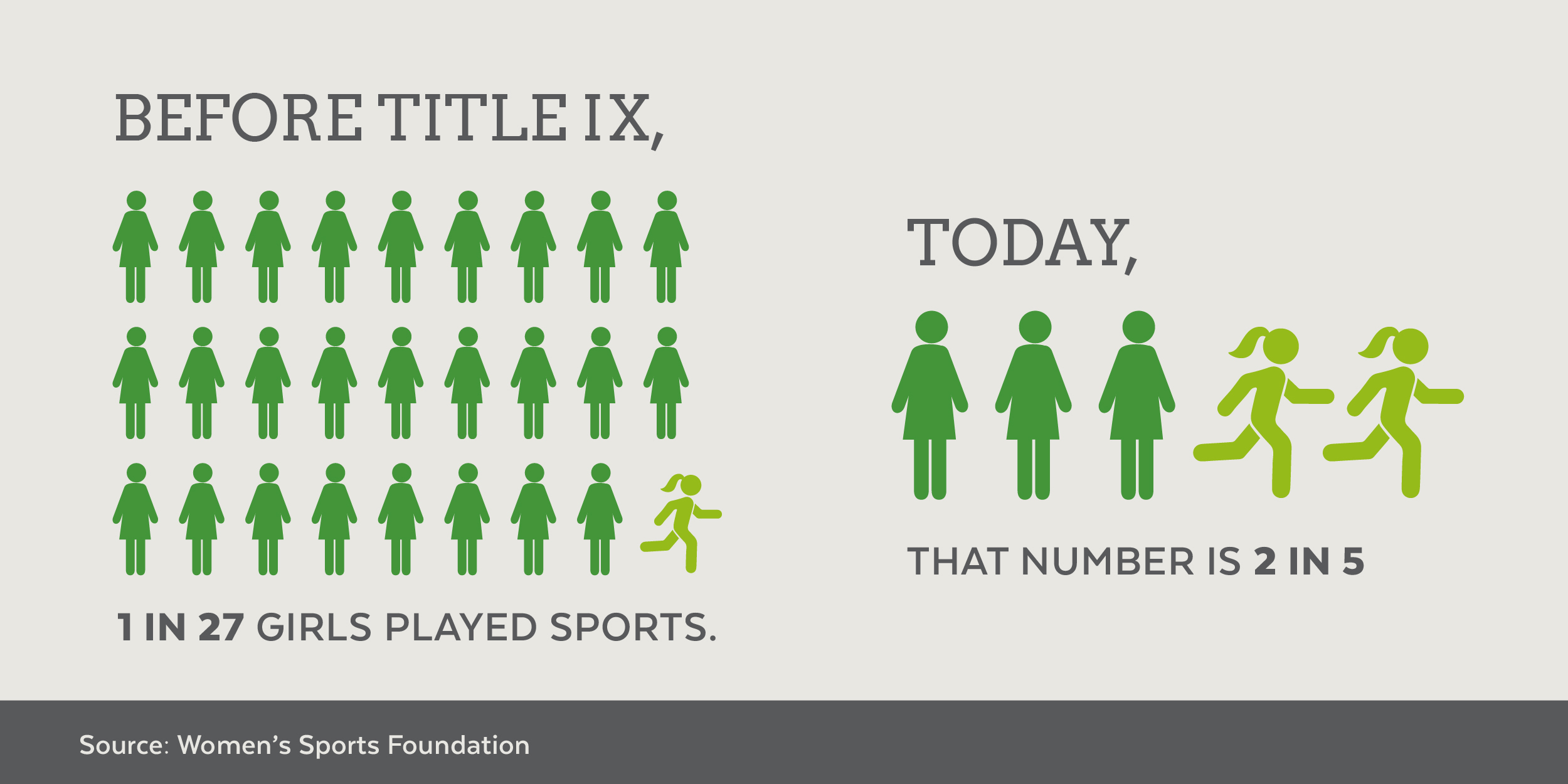
Graphic by Judy Blomquist/Harvard Staff
Gazette: Where do you think its greatest impact has been?
Gersen: Title IX’s most palpable impact has been the one that was most obviously envisioned by Congress: the prohibition of formal inequality in the treatment of males and females by schools that partake of federal funding. It’s important not to take that impact for granted. But in our era, the deepest impact of Title IX has been on schools’ bureaucratic and administrative structures and practices in order to implement the federal government’s expectations, based on its interpretations of Title IX, for dealing with campus allegations of sex discrimination, sexual harassment, and sexual assault.
Ware: It is clear that Title IX has had a transformative impact on many aspects of women’s experience in higher education, starting with sports but then later engaging with issues of sexual harassment and sexual violence on campus. It really has made a very large difference. It’s also proven handy having a law on the books that you can point to when something is wrong at your university. You can say, “This violates Title IX,” or “I’m going to file a Title IX complaint.” If you compare now and 1972 and look at the state of women’s sports, which were nonexistent, basically, and at the number of women faculty at Harvard or any other institution, the number of women in professional schools — just a whole range of things — it really has been a huge change.
I think there should have been more change. With sports it went from zero to 40 percent, but I’d like it to keep going, and I’d love it if half the faculty at Harvard or any other place were women. But it’s much better than when I was there in graduate school, when just the thought of having a woman faculty member in the History Department seemed like shooting for the moon. I think one of the best characterizations I’ve heard about Title IX is that it’s sort of like the guillotine out in the courtyard: It has an impact just because of its existence that is different from having complaints filed against the school and threatening to withdraw funds. It says, “Sex discrimination is illegal in higher education.” I think a lot of the change has come from that.
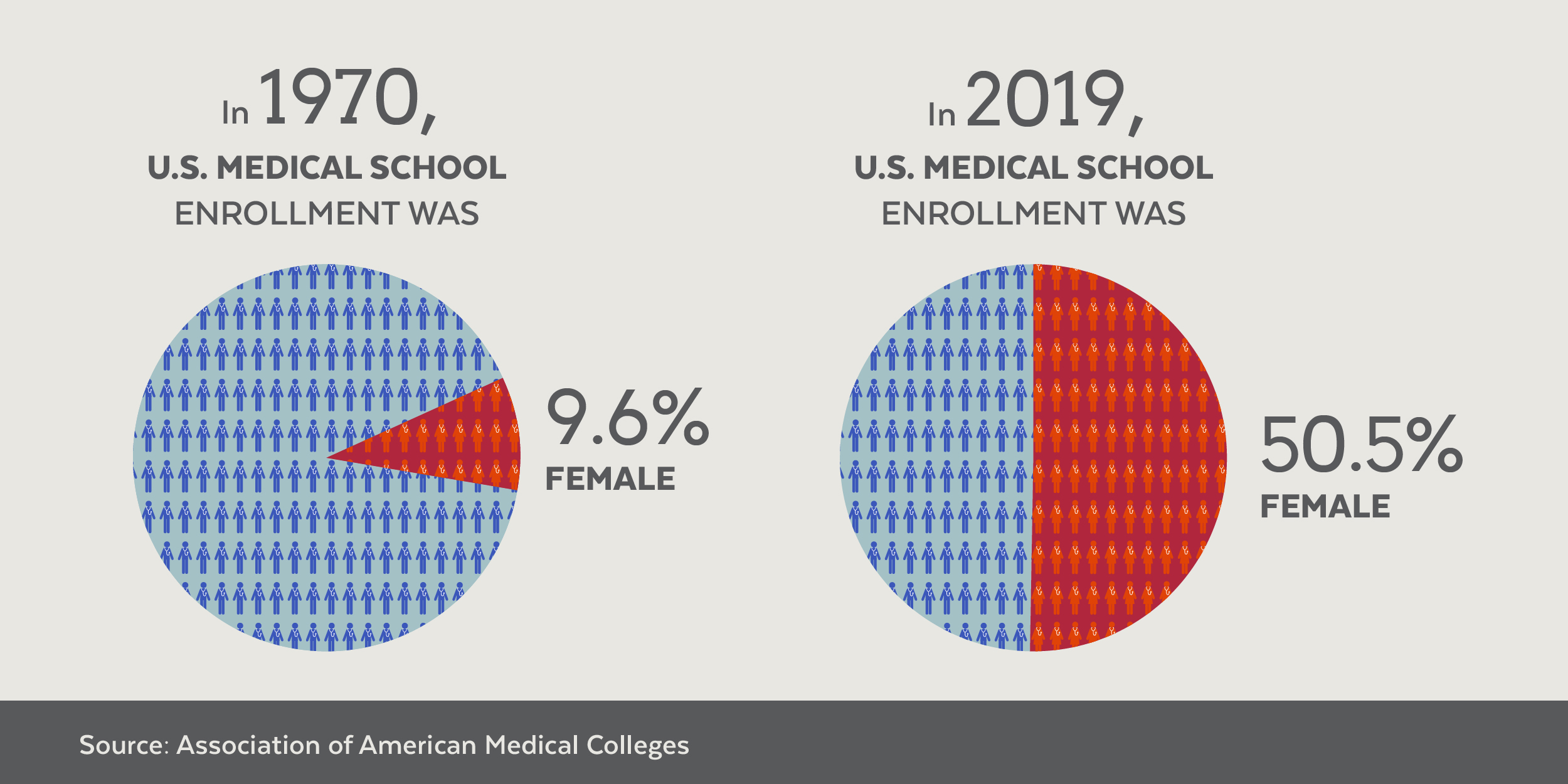
Gazette: How about the rights of transgender students?
Gersen: One of the signature Title IX debates of our decade is how the law’s prohibition on sex discrimination in education applies to transgender students. Last year, the Supreme Court interpreted Title VII’s prohibition on sex discrimination in employment to apply to discrimination against transgender individuals because it reasoned that treating a person differently because they are transgender is a form of discrimination on the basis of sex. It is unclear exactly what this means for the currently controversial issue of transgender female athletes competing in girls’ and women’s sports. On this issue, we have a lot of debate ahead on what it means to discriminate on the basis of sex, and what it means to provide the sexes equal educational opportunity.
Gazette: Do you think it has impacted you and your academic career?
Gersen: Of course Title IX has impacted the opportunities afforded me as a student and a professor, and the fact that Title IX was sponsored by Patsy Mink, the first Asian American congresswoman, has been meaningful to me as well. I think the simplicity of the promise of equal opportunity in Title IX combined with the complexity of its meaning, evolution, and implementation — and the work that is needed to explicate and apply it in a changing society — have deeply impacted my academic career.
Ware: I graduated from college in 1972, and I’m a good athlete. I run. I play tennis. I would have loved to play on a team, but I never got a chance to. In terms of my own professional advancement as a scholar, I have been in academia for my whole career, and I have seen the changes in the acceptance of women faculty, their numbers and pay equity and things like that. But I’m also well aware that you have to pay attention because if you start comparing salaries in a history department, you realize that the men are still getting paid more than the women, sometimes with rather large discrepancies. You just have to keep at it. Maybe some time we won’t still need to, but it doesn’t seem like it’s going to happen in my lifetime. Change happens slowly.
Gazette: What do you see ahead for the law’s continuing implementation?
Gersen: It is difficult for me to imagine a time when the meaning of Title IX will be completely settled.

Share this article
You might like.
Cass Sunstein suggests universities look to First Amendment as they struggle to craft rules in wake of disruptive protests

Experts say tension between trade, green-tech policies hampers climate change advances; more targeted response needed

New book by Nieman Fellow explores pain, frustration in efforts to help loved ones break free of hold of conspiracy theorists
Billions worldwide deficient in essential micronutrients
Inadequate levels carry risk of adverse pregnancy outcomes, blindness
You want to be boss. You probably won’t be good at it.
Study pinpoints two measures that predict effective managers
Weight-loss drug linked to fewer COVID deaths
Large-scale study finds Wegovy reduces risk of heart attack, stroke
- Election 2024
- Entertainment
- Newsletters
- Photography
- AP Buyline Personal Finance
- AP Buyline Shopping
- Press Releases
- Israel-Hamas War
- Russia-Ukraine War
- Global elections
- Asia Pacific
- Latin America
- Middle East
- Election results
- Google trends
- AP & Elections
- U.S. Open Tennis
- Paralympic Games
- College football
- Auto Racing
- Movie reviews
- Book reviews
- Financial Markets
- Business Highlights
- Financial wellness
- Artificial Intelligence
- Social Media
EXPLAINER: What is Title IX and what impact has it had?

FILE - In this Nov. 21, 1979 file photo, Bella Abzug, left, and Patsy Mink of Women USA sit next to Gloria Steinem as she speaks in Washington where they warned presidential candidates that promises for women’s rights will not be enough to get their support in the next election. Title IX, the law best known for its role in gender equity in athletics and preventing sexual harassment on campuses, is turning 50. It was signed into law by President Richard Nixon on June 23, 1972, after being shepherded through Congress in part by Rep. Patsy Mink, a Democrat from Hawaii who was the first woman of color elected to the U.S. House. (AP Photo/Harvey Georges, File)
FILE - First Lady Eleanor Roosevelt, Assistant Director of Civilian Defense, testifies in Washington D.C. on Jan. 14, 1942, before the Tolan Special House Committee studying migratory worker problems in connection with the defense program. The arrival of Title IX and its protections for American women was a long time coming and the result of hard work from the likes of Jeannette Rankin, Shirley Chisholm, Eleanor Roosevelt, Patsy Mink and more.(AP Photo/File)
FILE - Jeannette Rankin, 87-year-old former congresswoman from Montana, holds a news conference in Washington on Jan. 13, 1968, to discuss plans for an anti-Vietnam war demonstration near the Capitol. The arrival of Title IX and its protections for American women was a long time coming and the result of hard work from the likes of Jeannette Rankin, Shirley Chisholm, Eleanor Roosevelt, Patsy Mink and more.(AP Photo/Harvey Georges, File)
FILE - Rep. Shirley Chisholm D-N.Y., poses on the steps of the Capitol in Washington, March 26, 1969. The arrival of Title IX and its protections for American women was a long time coming and the result of hard work from the likes of Jeannette Rankin, Shirley Chisholm, Eleanor Roosevelt, Patsy Mink and more. (AP Photo/Charles Gorry, File)
FILE - Rep. Patsy Mink, D-Hawaii, meets reporters on Capitol Hill Wednesday Nov. 5, 1997, to call on the Senate Judiciary Committee to support Bill Lann Lee’s nomination to head the Justice Department’s civil rights division. The arrival of Title IX and its protections for American women was a long time coming and the result of hard work from the likes of Jeannette Rankin, Shirley Chisholm, Eleanor Roosevelt, Patsy Mink and more.(AP Photo/Joe Marquette, File)
FILE - In this Sept. 5, 1960, file photo, the medalists in the women’s 200-meter event, from left, bronze medalist Dorothy Hyman, of Great Britain; gold medalist Wilma Rudolph, of the United States, and silver medalist Jutta Heine, of Germany, pose with their medals at the Olympic stadium in Rome, Italy. It has been 50 years since Title IX was signed into law by President Nixon. The measure barred discrimination against women when it came to programs that receive federal assistance. (AP Photo/File)
FILE - In this Nov. 9, 1973 file photo, tennis star Billie Jean King speaks about sexual equality before the Senate education subcommittee in Washington, Nov. 9, 1973. (AP Photo/File)
FILE - Norma McCorvey, Jane Roe in the 1973 court case, left, and her attorney Gloria Allred hold hands as they leave the Supreme Court building in Washington, DC., Wednesday, April 26, 1989. . (AP Photo/J. Scott Applewhite, File)
FILE - Ann Meyers drives during practice at the NBA rookie camp for the Indiana Pacers in Indianapolis, Sept. 10, 1978. (AP Photo/File)
FILE - Sandra Day O’Connor waves after her unanimous confirmation by the U.S. Senate to the Supreme Court on Capitol Hill in Washington, D.C. in this Sept. 21, 1981 photo. Standing with O’Connor, from left to right, are: Attorney General William French Smith, Sen. Barry Goldwater, R-Ariz., Sen. Dennis DeConcini, D-Ariz., Vice President George Bush, and Senate Judiciary Committee Chairman Sen. Strom Thurmond, R-S.C. (AP Photo/J. Scott Applewhite, File)
FILE - Louisiana Tech women’s basketball coach Sonja Hogg is carried off the floor of McArthur Court in Eugene, Ore, following the Lady Techsters 79-59 win over Tennessee in the AIAW National Basketball Championship, March 29, 1981. (AP Photo/Harley Soltes, File)
FILE - Vice presidential candidate Walter Mondale, right, and congresswoman Geraldine Ferraro stand before a packed house at the State Capitol of the Minneapolis House of Representatives in St. Paul, Minn., Thursday afternoon, July 12, 1984. Mondale announced Ferraro, from New York, as his vice presidential running mate. (AP Photo/Larry Salzman, File)
- Copy Link copied
Title IX, the law best known for its role in gender equity in athletics and preventing sexual harassment on campuses, is turning 50 .
It was signed into law by President Richard Nixon on June 23, 1972 , after being shepherded through Congress in part by Rep. Patsy Mink, a Democrat from Hawaii who was the first woman of color elected to the U.S. House.
The law forbids discrimination based on sex in education, and despite its age remains a vital piece in the ongoing push for equality, including in the LGBTQ community.
WHAT DOES TITLE IX SAY?
The statute itself is one sentence long, language that was put together by then-Sen. Birch Bayh of Indiana, who died in 2019.
“No person in the United States shall, on the basis of sex, be excluded from participation in, be denied the benefits of, or be subjected to discrimination under any education program or activity receiving Federal financial assistance.”
Translation: The law is meant to ensure equity between men and women in education, and it’s broad, covering most K-12 schools and colleges and universities, as well as vocational schools, libraries and museums. That means it applies to tens of millions of students, as well as educators.
WHAT DOES TITLE IX COVER?
The law applies to several areas of education: athletics, the classroom, sexual assault and violence on campus, employment, discrimination, admissions, retaliation and even financial assistance with tuition.
It also has been extended to other forms of gender and sex discrimination; Title IX was invoked when the Obama administration advised that transgender people should be allowed to use the bathroom of their choice in schools.
HOW DOES TITLE IX AFFECT ATHLETICS?
In so many ways, and at the K-12 and powerful collegiate levels. Women’s and men’s teams are to be treated equally under the law, and schools should look to expand the opportunities for women to play sports .
This doesn’t necessarily mean that each sport will have exactly the same budget for equipment, facilities, travel or meals. For example, the women’s tennis team might have more money put toward racquets than the men’s tennis team. Athletic departments work under what is known as “equal in effect,” meaning a benefit for a men’s or women’s team in one area can be offset in another area as long as “the overall effects of any differences is negligible.”
In the hopes of ensuring compliance with Title IX, each athletic department at a college or university must provide annual Equity in Athletics Data Analysis reports . These track participation, coaching staff and salaries, revenues and expenses, including recruiting and game-day expenses.
Many Title IX athletics disputes deal with what’s known as the participation gap . Athletic departments must make sure the ratio of men’s athletic participation opportunities to women’s participation opportunities are “substantially proportionate” to a school’s undergrad enrollment.
For example, the University of Connecticut settled a lawsuit after its women’s rowing team won a temporary restraining order against being shut down. UConn was accused of putting inflated women’s rowing roster numbers (about 20 more than would compete) on its equity report, meaning the actual participation gap was “well above a viable team size.”
HOW DOES TITLE IX AFFECT SEXUAL HARASSMENT ALLEGATIONS?
Title IX’s protections extend to sexual harassment on campus , including dating violence, domestic violence and stalking.
The bottom line is that all students are supposed to have a learning environment free from sexual harassment. When violations occur, the law is meant to help students get the problem resolved, which can mean moving to a different dorm, for example, or getting an alleged attacker removed from the school entirely.
Under new Title IX regulations that were finalized in 2020, students who come forward with abuse allegations may now face an in-person hearing and cross-examination by a person chosen by the alleged attacker. These rules have been criticized by Democrats and others for not fully protecting victims and for discouraging complaints, and the Biden administration is expected to propose new regulations soon .
The Associated Press reported that some universities saw a decrease in the number of complaints brought to Title IX offices.
WHAT ABOUT DISCRIMINATION?
Under Title IX, there’s a broad definition of discrimination that could involve students, faculty, administrators or staff. It also covers discrimination against pregnant people. The law has also been invoked to outlaw discrimination of LGBTQ students and educators.
Nothing in Title IX or its federal regulations explicitly protects LGBTQ people, but the Biden administration said last year that the law should be interpreted to protect against discrimination based on sexual orientation or gender identity . It was based on a 2020 Supreme Court decision ruling that LGBTQ people are protected from discrimination in employment.
As a result, the Education Department said it can launch a civil rights investigation if students are blocked from things like using bathrooms or joining sports teams that match their gender identities.
Tennessee and several other Republican-led states filed a federal lawsuit challenging that guidance; it has yet to be decided.
The Biden administration has signaled that its upcoming regulation will explicitly expand Title IX to protect LGBTQ students from discrimination. If finalized as a federal regulation, it would carry the force of law.
WHO OVERSEES TITLE IX IN SCHOOLS?
Every school and college is supposed to have at least one Title IX coordinator, whose function is to make sure the institution is in compliance with all arms of Title IX. Sometimes the officer is simply the school’s principal, while many universities have whole offices dedicated to Title IX compliance.
WHAT TYPES OF COMPLAINTS CAN BE FILED?
There are two types: local and federal.
Local grievances run through the school’s Title IX coordinator or office, which have procedures in place to handle cases involving sex discrimination, sexual harassment and sexual violence. The schools can dole out discipline for these grievances.
Federal complaints go to the Education Department’s Office for Civil Rights. These investigations can take months or years to complete. The list of current federal Title IX investigations can be found at the OCR’s website .
Those who believe their rights have been violated can also bring their cases to federal courts through Title IX lawsuits.
For more on Title IX’s impact, read AP’s full report: https://apnews.com/hub/title-ix
Video timeline: https://www.youtube.com/watch?v=NdgNI6BZpw0
The Associated Press education team receives support from the Carnegie Corporation of New York. The AP is solely responsible for all content.


Title IX: Falling short at 50
Despite tremendous gains during the past five decades, many colleges and universities fall short of title ix, leaving women struggling for equity..
USA TODAY’s “Title IX: Falling short at 50” exposes how top U.S. colleges and universities still fail to live up to the landmark law that bans sexual discrimination in education. Title IX, which turned 50 in summer 2022, requires equity across a broad range of areas in academics and athletics. Despite tremendous gains during the past five decades, many colleges and universities fall short, leaving women struggling for equal footing.
What happens if a school doesn’t comply with Title IX? Not a whole lot.

Enforcement of the federal gender-equity law is essentially toothless, mired in red tape and delays as aggrieved students wait years for relief. Read the story

Colleges expel few sexual misconduct offenders while survivors suffer
Tens of thousands of sexual misconduct reports filed across dozens of colleges led to just 1,094 students suspended and 594 expelled over seven years. Read the story
How many students did your university suspend or expel for sexual misconduct under Title IX?

Explore the results of a first-of-its-kind data analysis of Title IX case outcomes from dozens of the nation’s largest public universities. Explore the data

She reported him for rape, but he stayed on campus and struck again
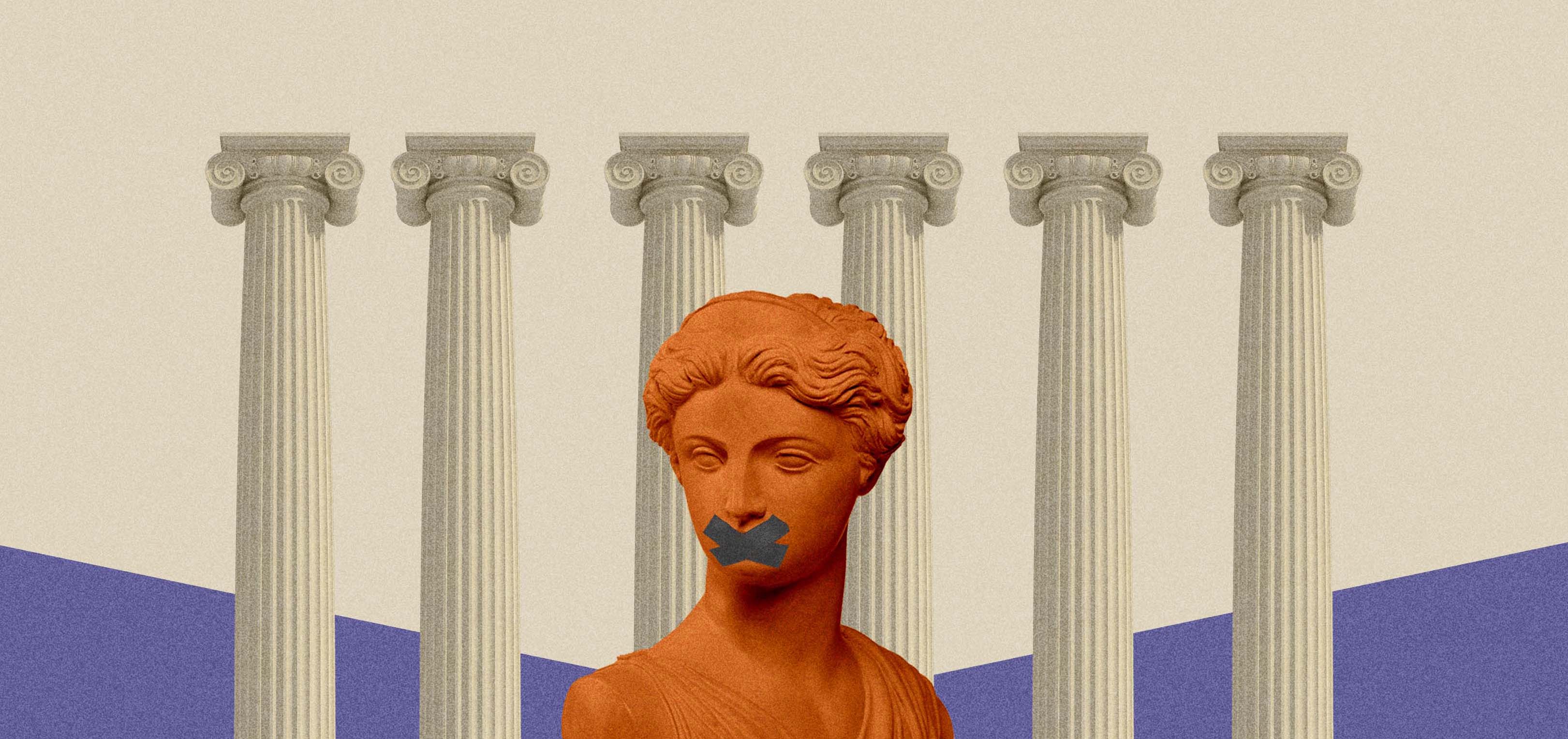
Marshall University didn’t expel a student after a rape claim. Victims reveal how the school failed them under Title IX. Read the story

Female athletes stiffed on scholarship money at top US colleges
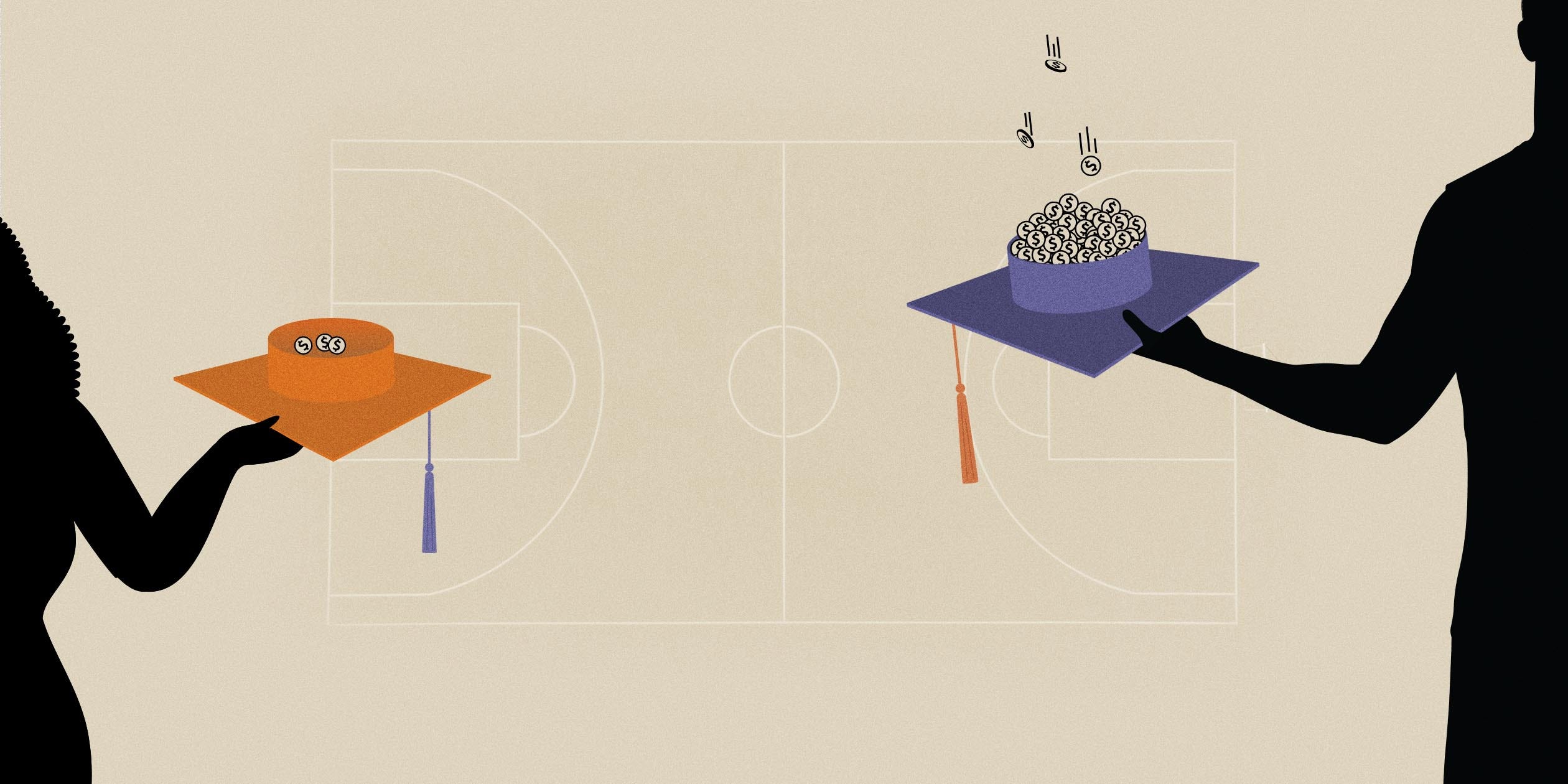
The schools that cheated women of their fair share should have given them $23.7 million more in athletic scholarships in 2020-21, USA TODAY found. Read the story
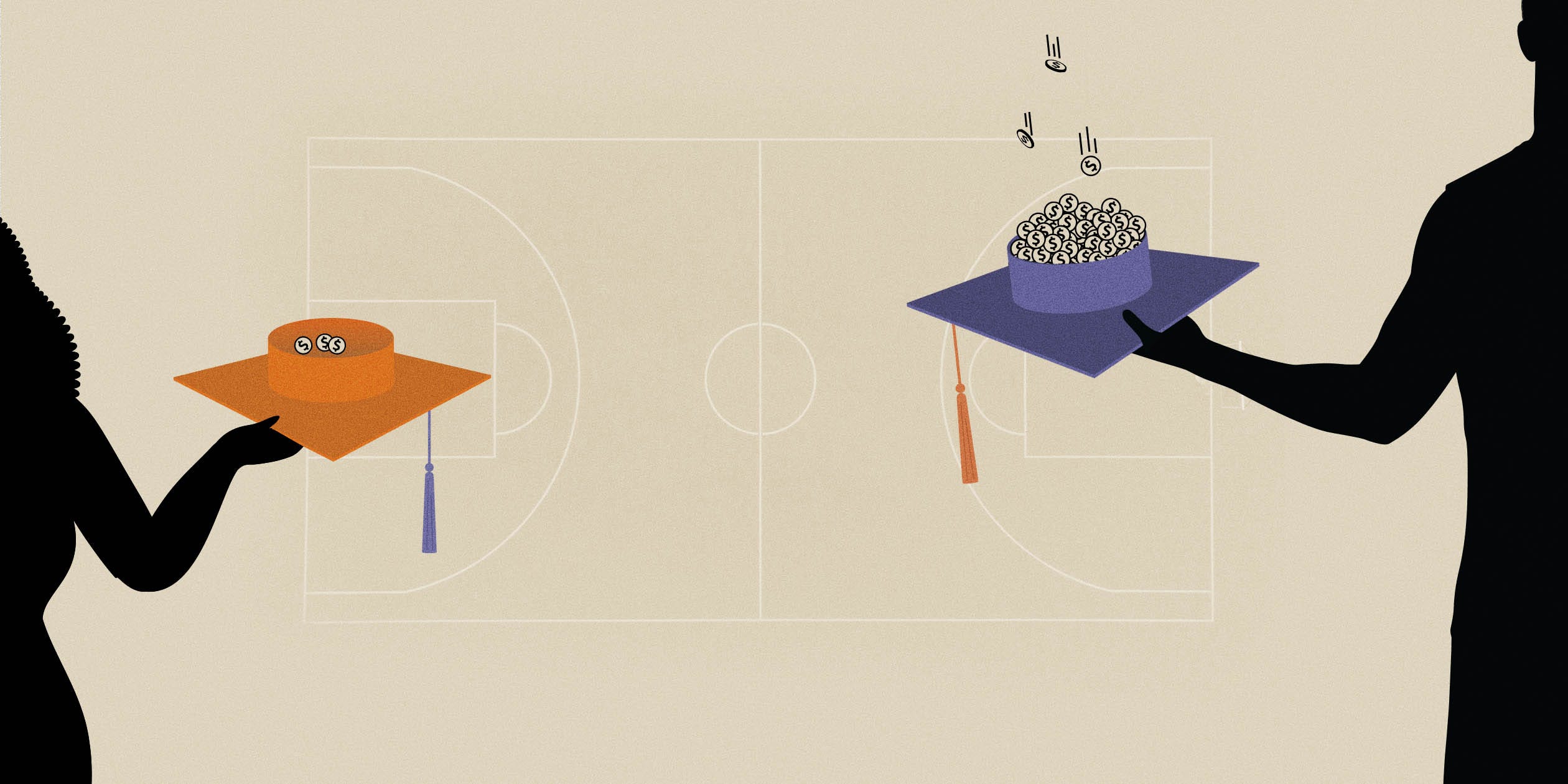
5 charts show athletic scholarships’ bias toward football — and against women

While most football and basketball players receive full-ride scholarships, many athletes' aid falls short of covering their college costs. Explore the graphics

Women still underrepresented in college sports 50 years after Title IX
Many of the nation’s top football colleges don’t give enough roster spots to women. Read the investigation
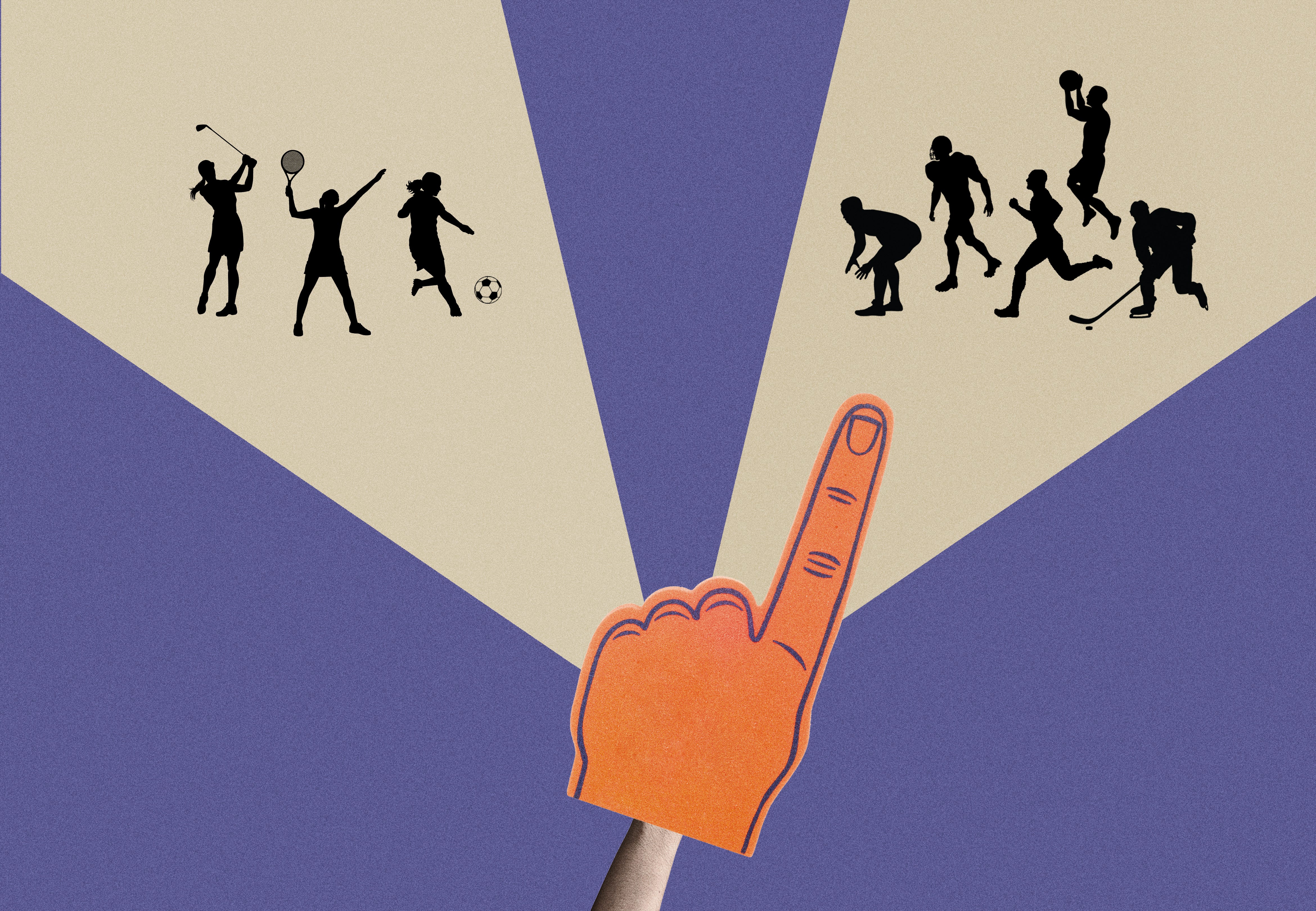
Padding the numbers
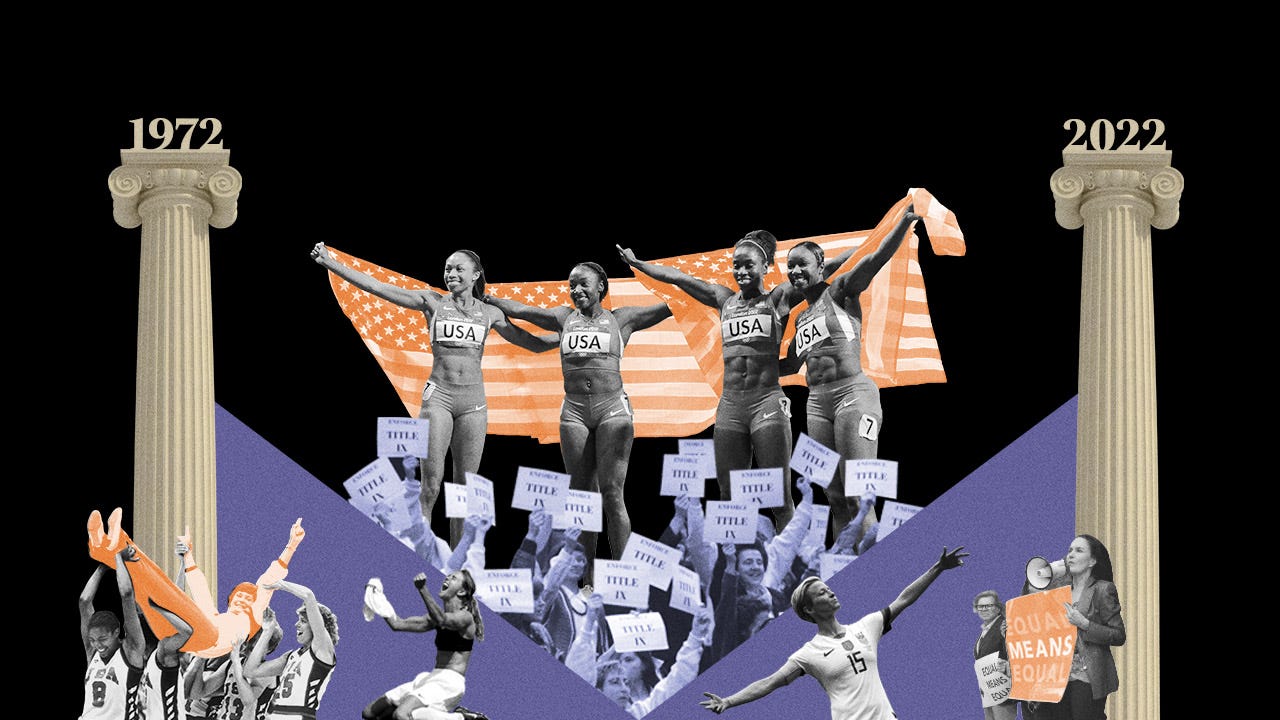
Title IX was intended to close the gender gap in college athletics. But schools are rigging the numbers. Read the investigation
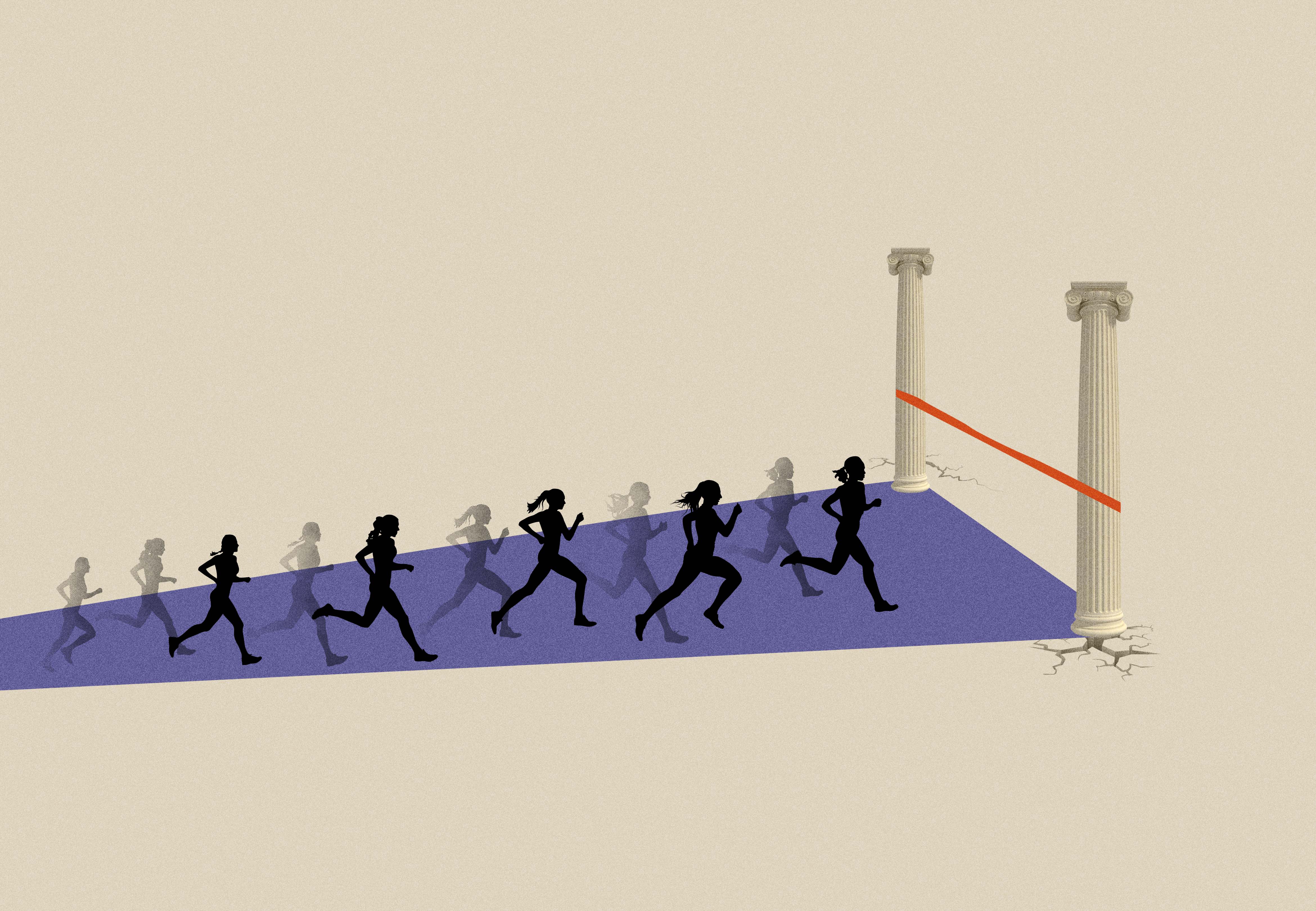
Explore the timeline
Title IX aimed to get women into grad schools. Over 50 years, it shaped their role in sports. Learn more
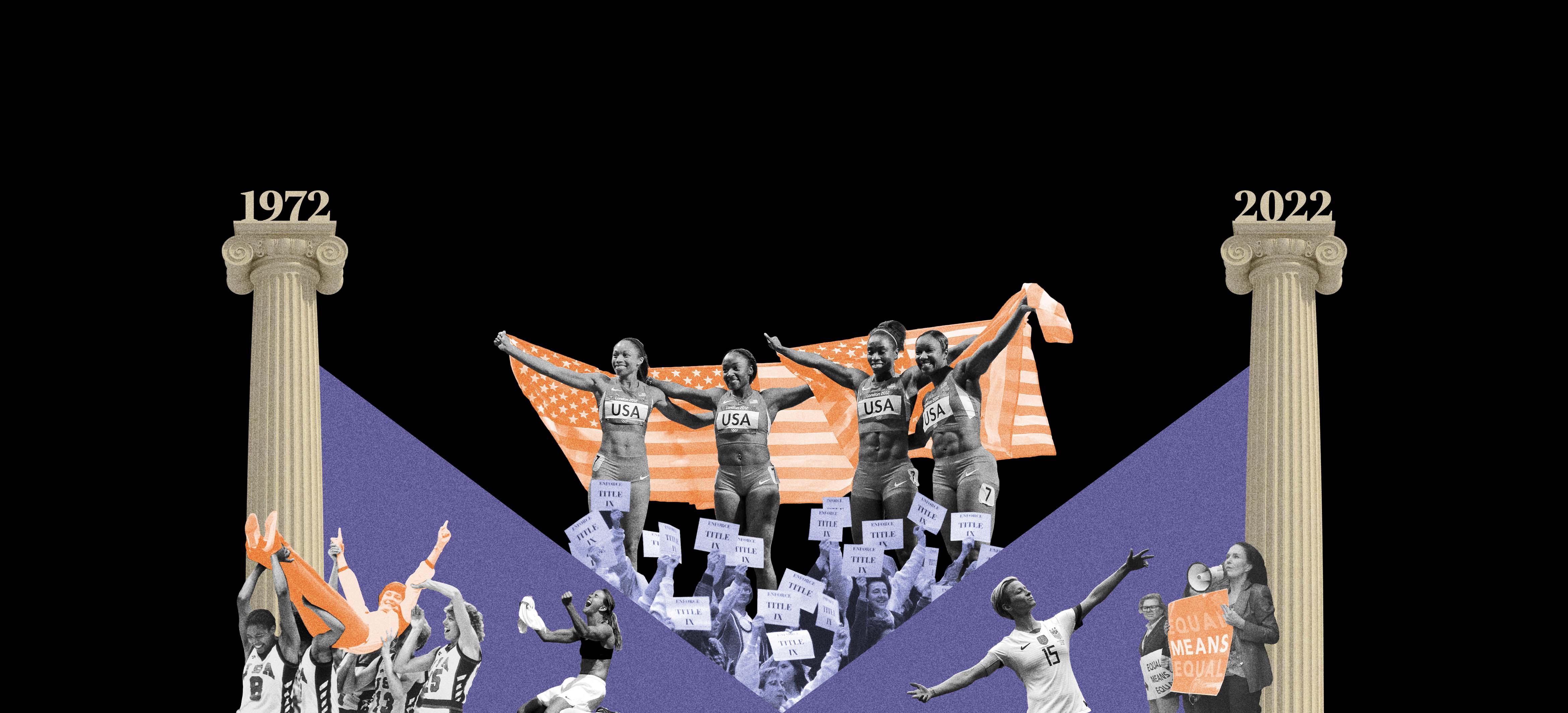
Is your school skirting Title IX’s intent?
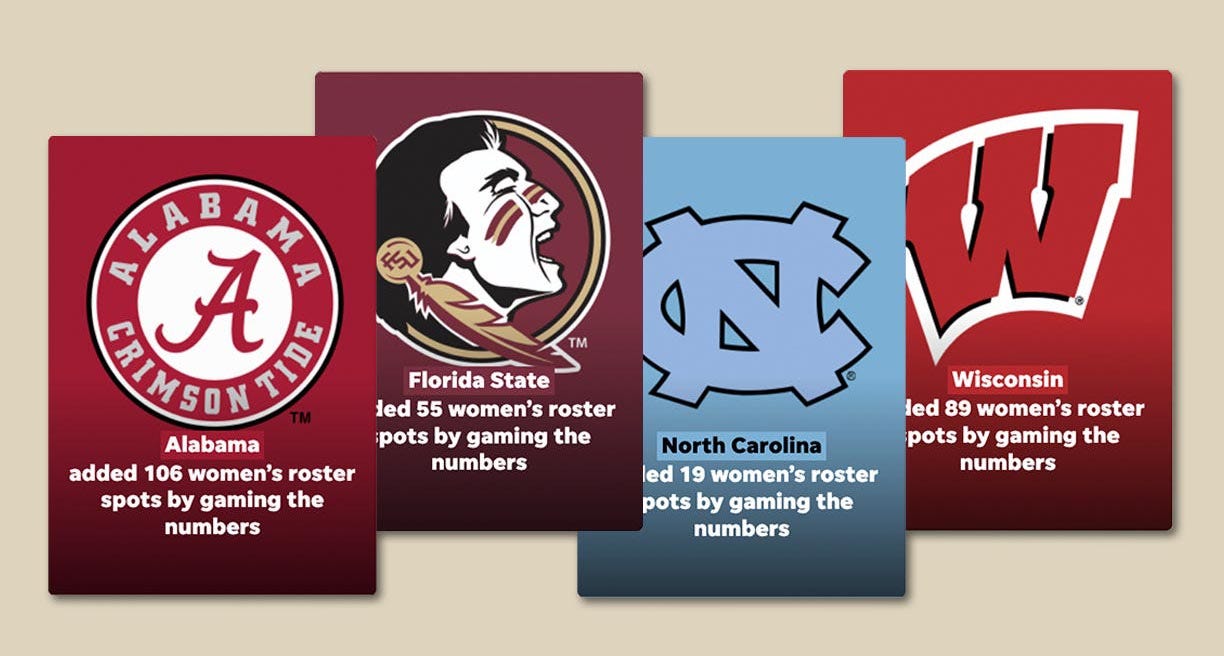
See which colleges inflated their women's rosters to look more balanced and how they did it. Explore the analysis
How to game the numbers for Title IX

You're the new athletic director at Big State University. How can you make your women's sports rosters look bigger without adding any new teams? Explore the graphic novel

Breaking down the roster numbers

College athletic programs rely on three key methods to boost women's roster spots without adding new teams or athletes. Explore the data

‘They’ve had 50 years to figure it out’
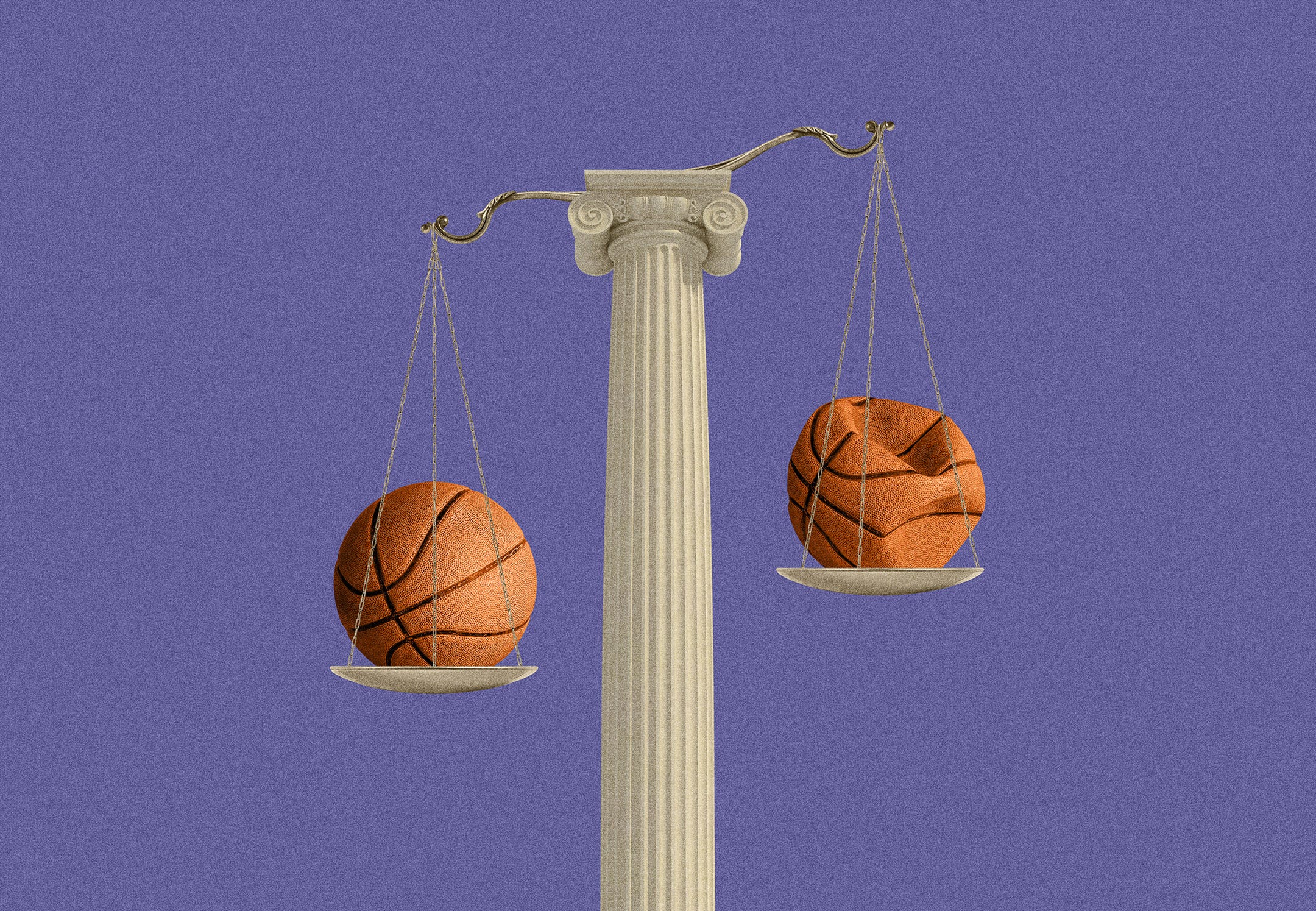
Despite progress driven by Title IX, colleges devote fewer resources to women’s sports, based on a first-of-its-kind data analysis by USA TODAY. Read the investigation

Funding of college sports falls short of law’s promise to women

Eight charts detail the disparities in spending on men’s and women’s sports in similar major college programs. Explore the graphics

Inside the numbers
Searchable data offers glimpse into how colleges short-change women’s sports. Search the data
Q&A on law’s impact
Misconceptions persist about how Title IX is enforced, what protections it affords women, and if it’s unfair to male athletes. Read the Q&A
Related investigations
- Fresno State president mishandled sexual harassment complaints. Now he leads all 23 Cal State colleges.
- 'Fractured and ruined': How Fresno State's understaffed Title IX office failed students on Joseph Castro's watch
- A Cal State dean groped two colleagues. ‘Retreat rights’ made him unfireable.
The Title IX risk landscape: What you need to know
Title IX, the landmark civil rights law passed in 1972 prohibiting discrimination on the basis of sex in federally assisted educational programs and activities, is receiving increased attention relative to how sexual assault cases are handled on campuses around the country. Title IX is no longer known only for its role in gender equity in athletics or employment, but also in how it defines a college or university’s responsibility to prevent and respond to alleged sexual assaults in campus communities.
With the 2013 Violence Against Women Act and a 2011 Dear Colleague Letter from the Department of Education Office of Civil Rights (OCR), the complexities of interpreting Title IX continue to increase. Earlier this year, the White House created a Task Force to Protect Students from Sexual Assault. Most recently, the Task Force published new resources, while OCR issued new guidance and made public the names of 60 institutions that are currently under investigation related to sexual assault.
In this period of heightened awareness, how can colleges and universities proactively address the myriad of regulations and guidance? In this webinar, we discuss the changing risk landscape of Title IX and address the following:
- Practical approaches for proactively assessing an institution’s policies, procedures, practices, and roles and responsibilities relative to Title IX
- Questions that governing bodies should be asking about Title IX compliance
- Steps for internal auditors and senior leaders to take in order to provide responses to those questions
- A case study of one institution’s recent Title IX internal assessment approach; the challenges that were identified in the institution's organizational structure, communication, and procedures; and the involvement of the institution’s governing board
Learning Objectives:
- Understand the elements of Title IX and major associated compliance risks
- Describe practical steps to consider in addressing compliance with Title IX
- Provide examples of universities roles and responsibilities related to Title IX processes and procedures related to sexual assault
Download this presentation
For more information on this topic, or to learn how Baker Tilly higher education specialists can help, contact our team .
Related sections
- Higher Education
Article Tags

Qualitative analysis: the construction site visit
The Younger Victims of Sexual Violence in School
Conversations about Title IX tend to focus on college, but cases among K-12 students are abundant and often poorly handled.

After telling school officials she was raped in the band room, Rachel Bradshaw-Bean was punished. Instead of receiving protection from leaders at her Texas high school, she was kicked out and shipped off to an alternative school —alongside the boy she said attacked her.
In California, 13-year-old Seth Walsh killed himself after telling classmates he was gay. Walsh faced two years of relentless and escalating harassment after coming out, investigators said, but school officials failed to address the abuse until it was too late. In 2010, he hanged himself.
In both of those cases, the K-12 school districts reached agreements with the U.S. Education Department’s Office for Civil Rights, after federal investigators found local education officials had failed their obligation to protect students from gender-based violence under Title IX, which prohibits sex discrimination in schools. In each case, district leaders promised they’d create new school policies to better protect student safety.
Adele Kimmel is banking on a similar outcome for her client. A Washington, D.C.-based senior attorney at Public Justice, Kimmel has for several years been representing sexual-violence victims, including a young Georgia woman who allegedly also faced retaliation for reporting an attack . Inside a Gwinnett County high school’s newsroom, Kimmel said, a male classmate coerced the young woman into performing oral sex. After she reported the purported incident to school officials, she was suspended for engaging in sexual acts on campus. But first, Kimmel contended, educators grilled her client with bone-chilling questions: “What were you wearing?” “Why didn’t you scream louder?”
Gwinnett County Public Schools is currently one of 137 K-12 school districts under investigation by the Office for Civil Rights for 154 Title IX sexual-violence complaints, according to a spreadsheet, dated August 2, the department provided to The74Million.org, which published this story in partnership with The Atlantic . The pending investigations—against public districts, private institutions, and charter school networks in 37 states and the District of Columbia—stretch back as far as December 2010. On the university level, the office currently has 350 investigations pending at 246 postsecondary institutions, according to an Education Department spreadsheet also dated August 2.
“What you see most commonly is that colleges are far ahead of K-12 schools in the development of their sexual-misconduct policies and procedures, their training, and their education of staff and students, making sure that students know who the Title IX coordinator is,” Kimmel said. “My concern is that—with the changes that seem to be coming from the Department of Education’s Office for Civil Rights—K-12 schools are going to fall even further behind in terms of Title IX compliance.”
Victims of sexual assault on college campuses found a national platform as the Obama administration placed a clear focus on Title IX enforcement, most notably for articulating the evidentiary standard for findings of wrongdoing in campus sexual-violence cases. While K-12 schools have largely been left out of the debate, in recent years the Office for Civil Rights has seen a surge in Title IX complaints against these schools similar to those targeted at colleges and universities.
Following a series of July listening sessions with victims of sexual violence, students who say they were unfairly punished under Title IX, and education leaders, DeVos is contemplating a philosophical and practical shift at the department’s civil-rights division, which the new administration plans to revive as a “neutral, impartial, investigative agency.” “A system without due process ultimately serves no one in the end,” DeVos said .
“There are some things that are working. There are many things that are not working well,” she told reporters . “We need to get this right.”
Obama-era Title IX guidance has been a thorn for Republican lawmakers and advocates who have alleged—including in lawsuits —that the former administration stripped due-process rights from students accused of sexual harassment and assault. At the heart of that complaint is a 2011 “Dear Colleague” letter that urged colleges and K-12 schools to better investigate reports of sexual violence, specifying that educators “must use a preponderance of the evidence standard” in campus investigations, rather than the more rigorous “clear and convincing” standard. Advocates for sexual-assault victims note the “preponderance of the evidence” standard is used to adjudicate other civil-rights claims, including discrimination.
Jayne Ellspermann, a former principal in Florida, acknowledged that while K-12 leaders across the country have an obligation to ensure students are safe on school grounds, districts vary in their sexual-assault-prevention measures. Some have robust supports with clear guidelines and procedures, she said, but in other communities “this situation might not have ever occurred and they don’t have a framework to work with.”
She said federal oversight is beneficial for communities lacking strong procedures, but “the local level is the most appropriate” place for situations to be handled. “We need to trust the schools and law enforcement and the local social-service agencies to do their jobs to support students and schools in situations like this,” said Ellspermann, who recently completed a one-year stint as the president of the National Association of Secondary School Principals.
In response to potential policy shifts under the DeVos administration, Ellspermann said it’s important to “to look at different procedures and ensure that they are appropriate for the current day and time.”
Gwinnett County Public Schools did not respond to requests for comment. Naomi Gittins, the managing director of the National School Boards Association, and Phillip Hartley, its vice chair, were listed among those who attended a Title IX listening session with DeVos, but neither responded to requests for comment. Francisco Negron, the group’s chief legal officer, could not be reached for comment.
After the Obama administration released its 2011 guidance, Negron raised several concerns, joining the ranks of some college officials who have argued it’s vague and inconsistent. The department, he told Education Week , needed to better clarify when an off-campus incident should prompt school-district intervention.
“Say the allegations haven’t been proven,” Negron said at the time. “It’s not clear from the department’s guidance what the district’s responsibility would be.”
The prevalence of child sexual abuse is difficult to pinpoint because victims often do not report the attack, though studies have shown about 20 percent of girls and over 5 percent of boys are victims of sexual abuse. In fact, 44 percent of attacks take place before the victim enrolls in college. And children who experience sexual violence are nearly 14 times more likely to experience rape or attempted rape in their first year of college, according to the National Center for Victims of Crime.
More than half of attacks occur at or near the victim’s home, and 8 percent take place on school property, according to the Rape, Abuse and Incest National Network.
In the first year of Obama’s presidency, in 2009, the Office for Civil Rights received just 11 Title IX sexual-violence complaints against K-12 schools, according to federal figures . That number jumped to 83 in 2016, totaling 269 K-12 complaints over the eight-year period.
Officials at the Office for Civil Rights also resolved 371 sexual-violence complaints against K-12 schools and colleges, with investigations often taking up to several years to complete. Among cases resolved was a compliance review of California’s West Contra Costa Unified School District, where federal officials concluded following a 2009 high-school gang rape that sexual harassment among students “permeated the district’s elementary and secondary schools.”

Despite the sharp increase in complaints, the numbers don’t indicate a surge in sexual violence, Catherine Lhamon, the Education Department’s assistant secretary for civil rights under Obama, told The 74 in June . Rather, she said, the increase suggests more and more people saw OCR as an avenue for relief. Nationally, the rate of sexual assault and rape in general has fallen more than 60 percent in the last two decades. Although research has varied, studies suggest between 2 percent and 8 percent of sexual-assault complaints are false.
“Also, there was a galvanizing movement around the country of securing change on those topics, and so it prompted more people to feel safe coming forward,” Lhamon said. “Over too many decades, sexual harassment and sexual violence have been categories of shame for people who have experienced them, and it has been hard for them to come forward.”
In the late 1990s, the U.S. Supreme Court issued two rulings that set standards for when schools and colleges can be held liable under Title IX for failing to prevent student-on-student and teacher-on-student sexual harassment and assault.
Yet at the high-school level, more than 80 percent of guidance counselors feel ill-equipped to address reports of abuse, according to Break the Cycle, an organization that addresses teen dating violence. “I wish I was seeing a trend where schools are becoming increasingly knowledgeable and better trained in the K-12 setting, but I’m not,” said the Michigan-based attorney Monica Beck of the Fierberg National Law Group . “I think a lot of people don’t understand the prevalence of sexual assault in this country’s schools.”
Along with defining the evidentiary standard, Obama-era guidance documents directed districts to hire Title IX coordinators to oversee compliance, promptly investigate and resolve complaints, and provide reasonable accommodations to victims so they can pursue an education in a safe environment. Failure to comply, the department noted, could cost a district its federal funds—an extreme measure that’s never been used against either a K-12 school or a college or university.
Generally, districts sign voluntary resolution agreements and promise changes if the Office for Civil Rights finds they aren’t compliant with the law, as was the case with Rachel Bradshaw-Bean’s district in Henderson, Texas, and Sean Walsh’s district in Tehachapi, California.
In the last few months, the Trump administration has already shown Obama-era guidance letters are easily reversed. In February, the Departments of Education and Justice rescinded an Obama-era “Dear Colleague” letter that said Title IX prohibits discrimination based on gender identity, not just a student’s sex at birth.
Former Obama education officials maintain, however, that reversing guidance letters won’’t change the protections and legal obligations laid out in Title IX.
Even as the Georgia student waits for the Education Department to reach a verdict in her case, her reporting has already prompted changes in Gwinnett County schools, Kimmel said. For example, the district now has a website that identifies its Title IX coordinators and district policies. A ruling could force additional changes.
After the student filed a complaint with the office, investigators launched a compliance review, Kimmel said, which looks at three years of district complaint records to determine whether systemic civil-rights violations existed. “Part of the reason that students will file these complaints is that they’re looking to make changes so nobody else goes through what they did,” she said.
Under DeVos, however, the Office for Civil Rights has already laid out plans to roll back that review process, according to an internal memo sent by Candice Jackson, the acting head of OCR, and obtained by ProPublica.
In a statement, an Education Department spokesman said the office will use a “systemic” or “class-action” approach to investigations only if a complainant raises widespread issues or the department determines such issues exist through conversations with the complainant.
If the office limits or narrows its enforcement of Title IX, Kimmel said, victims may feel less empowered to report incidents because of a “chilling effect.” Requiring the “clear and convincing evidence” standard, she said, could make victims feel less empowered to report attacks if it’s harder to ensure their perpetrator is held accountable.
Christopher Perry, deputy executive director of Stop Abusive and Violent Environments, sees things differently.
He said he hopes the department replaces the current guidance with procedures similar to recent recommendations by an American Bar Association task force which, in some circumstances, seeks a higher standard of proof.
“What we’re trying to do is really put together a fair system that allows both parties to feel as though they were treated respectfully and that the outcome is reliable,” Perry said. “We want a full and fair investigation, we want both sides to be able to have adequate and timely notice of what’s going on. We would like a transparent hearing process.” He pointed to complaints from victims alleging that schools dismissed their cases without investigating them.
For that very reason—K-12 districts often fail to investigate complaints—changing the evidentiary standard may not have a huge effect on Beck’s work, she said, because she generally pursues justice through the courts, including in three pending cases. Among them, Beck represents four young women who say they were assaulted by former Major League Baseball Player Chad Curtis, who worked as a substitute teacher and volunteer weight-training instructor at a Michigan school district. In a 2013 criminal case, Curtis was found guilty of assaulting three of the young women.
Any change to the department’s Title IX guidance, however, could have ramifications for K-12 schools, Beck said.
“If the Department of Education even kind of takes its focus off of it, I can see that being very harmful to our nation’s students,” she said. “It’s really important, not only for schools to understand what their responsibilities are, but for students and parents to know what their rights are.”
This story was produced in collaboration with The74Million.org .
About the Author
More Stories
School-Security Companies Are Thriving in the Era of Mass Shootings
How Florida's Schools Are Welcoming Puerto Ricans

Call To Speak With Attorney Andrew Shubin
What Are Examples of Title IX Violations?
HOW WE CAN HELP GET YOUR FREE CONSULTATION
Fighting For Important Causes In State And Federal Courts
Title IX protects students across the country from sex-based discrimination in education. These rules apply to any educational institution that receives federal funding, working to stop discrimination and other related issues that affect students. Understanding what exactly Title IX prevents is often easier when you look at its protections in context. The Title IX violation attorney at The Law Office of Andrew Shubin explains some examples of Title IX violations that students in high school and college might face.
Common Instances of Title IX Violations
Title IX applies to any school or educational institution that receives federal funding. This means that these examples come not only from public schools, but also from private schools – and not just from sex discrimination in college , but also from sex discrimination in high school . Even some libraries and museums are considered educational institutions for the purpose of Title IX protections, and those workers and patrons might also be protected by Title IX.
Some of these examples come from issues and debates that have been common in the news over the past few years, so they may look familiar. Others may be quite rare, but they would still violate Title IX.
Sex Discrimination in Sports
One of the areas that people immediately think of when it comes to Title IX is athletics. High school and college athletics are required to remain free from sex discrimination under Title IX. The most common issue people might face from discrimination in sports is the unavailability of a team for them. For “non-gendered” sports like track or swimming, schools are usually required to have teams for boys/men and girls/women. This means that if your school only has a boy’s swim team or only has a women’s track team, it is likely a Title IX violation.
For “gendered” sports, there must typically be an alternative sport for the other students to play. This is why schools usually opt to have a baseball team for male students and a softball team for female students. If there is no alternative team for the other gender, students typically must be permitted to join the team even if they are not the “right sex” for the sport. For example, many high schools have female kickers on their football teams, as there is no girl’s football team or alternative sport.
Sex Discrimination in Education
When it comes to classes and educational opportunities, examples of sex discrimination would typically include programs or opportunities that are unavailable to some students because of sex. For instance, if a school had a male health class and a female health class, this would not violate Title IX as long as both classes offer similar education. However, the school may still be required to offer a co-ed version of these classes to ensure equality.
Another clear example of sex discrimination in education deals with discrimination based on a student’s pregnancy. This is often found to violate Title IX because pregnancy is inherent to female biology, so discrimination based on pregnancy would inherently discriminate against women.
LGBTQ Discrimination
One of the biggest issues of sex discrimination in the news in recent years has been how schools handle LGBTQ students. Specifically, these issues often come down to locker rooms use, bathroom use, and participation in gendered sports for trans, gender non-conforming, and non-binary students. Under the Obama administration, Title IX was used to instruct schools to allow students to use the bathroom or locker room they are most comfortable with. In recent years, there has been pushback by many across the country and reversal of many of these policies by the Trump Administration.
Gender discrimination is inherently done “on the basis of sex” because it deals with expectations and assumptions about another person’s sex, so many of these cases are still filed as sex discrimination claims, even with these new Title IX rules. Questions of which team trans athletes should participate on are still being decided throughout the country, but these issues likely qualify as Title IX gender discrimination violations as well.
Sexual Harassment
One of the strongest examples of Title IX issues is sexual harassment. Although this does not immediately seem like “discrimination,” any examples of rude comments or mistreatment of a sexual nature are inherently done “on the basis of sex.” Sexual harassment can violate Title IX whether it includes bullying, sexist comments, or mistreatment of someone because of their sex. Sexual harassment can also include quid pro quo harassment where opportunities or benefits are exchanged for or offered in exchange for sexual favors.
Sexual harassment in violation of Title IX can also involve workplace sexual harassment . Teachers, principals, and other educators are also protected from sex discrimination in their employment at federally funded schools.
On-Campus Sexual Assault
On college campuses, one of the number one Title IX issues is sexual assault on campus. Title IX creates rules and procedures that colleges need to follow for reporting and enforcement of policies and statistical research on safety from sexual assault. Because sexual assault is inherently linked to sex, and because female students face sexual assault at a disproportionate rate, sexual assault on college campuses is one of the biggest Title IX issues today. Institutional sexual assault (e.g., sexual assault by teachers or administrators) is also squarely within the issues governed by Title IX.
Retaliation
Lastly, students who face negative consequences, increased harassment, or disciplinary measures because they filed a Title IX complaint or lawsuit are protected from this kind of retaliation. This can allow them to seek further damages and protections for the retaliation.
Call Our Title IX Violation Lawyer for Help with Your Claim
If you or your child faced discrimination “on the basis of sex” while attending high school or college, call our civil rights attorney today. The Law Office of Andrew Shubin’s sex discrimination lawyer fights to get compensation and justice for victims of sex discrimination in high school and college. For a free legal consultation on your case, call us today at (814) 826-3586.
GET YOUR FREE CONSULTATION
- Email Address *
- Phone Number
- City/State *
- Tell us about your situation... *
- Comments This field is for validation purposes and should be left unchanged.
- Victims of Institutional Sexual Abuse
- Title IX Violation Attorney
- Victims of Sexual Harassment in the Workplace
- College Student Misconduct and Disciplinary Hearings
- Criminal Defense Attorneys for College Students

COMMENTS
This was later reduced to $4.52 million. Specifically, the jury ruled that 1) the university acted on the basis of Vivas's perceived sexual orientation, and 2) the university acted because Vivas was engaged in activity protected under Title IX—the protesting of sex discrimination on behalf of other individuals. In Jackson v.
Title IX Case Study #3 Doctors v. Green University Five doctors employed at Green University's Teaching Hospital filed suit against Green University, Green University Teaching Hospital, and Respondent doctor alleging violations of Title IX and Title VII of the Civil Rights Act of 1964. Respondent supervises all five doctors in
The conduct is objectively offensive. Coach Gandy was trying to motivate her players. The guys were just too lazy. When frustrated, she would berate them as being "wusses," "pussies," "douchebags," "bitches," and "pussycakes.". She did this many times to most of the players. Two of the players filed a complaint.
Why it's significant: It is the first sexual assault case to reach a federal jury trial since Obama introduced the 2011 guidance, according to media reports, though it claimed a state "breach of contract" rather than a Title IX violation. Where it is now: Decided. The jury awarded the student more than $100,000, a far cry from the $3 million he ...
Examples of Title IX violations. Some common examples of the types of discrimination covered under Title IX include: Sexual harassment. Failing to provide equal athletic opportunity. Sex-based discrimination in a school's science, technology, engineering, and math (STEM) courses and programs. Discrimination based on pregnancy.
The case was filed in the United States District Court for the Southern District of New York on May 9, 2003, by four current and former high school students and a school employee. The plaintiffs alleged that the school district and Mawhinney violated state and federal laws, including Title IX.
crimination based on sex.THE HISTORY OF TITLE IX5Title IX prohibits discrimination on the basis of sex in education programs and activities oper. ed by recipients of federal financial assistance. The fundamental principle underlying Title IX is that students may not be denied. educational opportunities based on their sex - aU.S. v. Virgi.
This case study included a purposeful sample of five geographically and demographically diverse districts that experienced an incident of school employee sexual misconduct in 2014, and lessons are drawn for addressing and preventing such cases through the implementation of the provisions of federal law Title IX.
A half century after its enactment, Title IX, the federal law that bars discrimination against women in education, has forced a leveling of the playing field on campus, though advocates say its work is still not done. In recent years, the law has forced a reckoning over sexual harassment and assault on campus, and its protections have been ...
7lwoh ,; ,psolfdwlrqv ri d 5hsruwhg 9$:$ 2iihqvh-rvkxd 9roohqgrui 'luhfwru ri &rpsoldqfh 7lwoh ,; $'$ &ohu\ &rruglqdwru *dwhzd\ 7hfkqlfdo &roohjh
Published 11:10 AM PDT, June 20, 2022. Title IX, the law best known for its role in gender equity in athletics and preventing sexual harassment on campuses, is turning 50. It was signed into law by President Richard Nixon on June 23, 1972, after being shepherded through Congress in part by Rep. Patsy Mink, a Democrat from Hawaii who was the ...
The goal was to provide a plethora of examples that can be used to spark conversations about attitudes, responses, and best practices related to gender- ... BRIEF CASE STUDIES. TRANSFORMING OHIO CAMPUSES A Toolkit for Implementing the Changing Campus Culture Initiative 4:4 Case Scenerios Courtney was raped. She refuses to say by whom, but she ...
USA TODAY's "Title IX: Falling short at 50" exposes how top U.S. colleges and universities still fail to live up to the landmark law that bans sexual discrimination in education. Title IX ...
A case study of one institution's recent Title IX internal assessment approach; the challenges that were identified in the institution's organizational structure, communication, and procedures; and the involvement of the institution's governing board; Learning Objectives: Understand the elements of Title IX and major associated compliance risks
In the first year of Obama's presidency, in 2009, the Office for Civil Rights received just 11 Title IX sexual-violence complaints against K-12 schools, according to federal figures. That number ...
"For more than 50 years, Title IX has promised an equal opportunity to learn and thrive in our nation's schools free from sex discrimination," said U.S. Secretary of Education Miguel Cardona. "These final regulations build on the legacy of Title IX by clarifying that all our nation's students can access schools that are safe, welcoming ...
Report Template?The Title IX Final Rules, issued May 19, 2020, mandate that all Title IX recipients follow a specific procedure for investigating formal complaints of sexual harassment covered under Title IX, including. sexual violence. The Title IX Grievance Process is developed and enforced according to the Institution's obligations under ...
Examples include a) Engaging in the following conduct without the knowledge and consent of all participants: 1. Observing, recording, or photographing private body parts or sexual activity of the complainant. ... Title IX Case Study #2 Plaintiff v. State of Blue • Respondent student was a student at Blue University's Lavender campus until ...
misconduct policy. For comparison, the scenarios include examples of consensual sex. The scenarios also provide examples of penalties-ranging from expulsion to reprimand-that might be imposed as a result of a violation. The scenarios are not drawn from actual cases heard by the UWC; the details of those cases are held in the strictest ...
Researchers analyzing reports of Title IX case outcomes from higher education institutions found ... For example, reflections on the Title IX process that I had initially coded with negative words like "depressed," "tired," "anxious," and "overwhelmed" were sorted into "negative feelings about process," while "relief" or ...
Sexual Harassment. One of the strongest examples of Title IX issues is sexual harassment. Although this does not immediately seem like "discrimination," any examples of rude comments or mistreatment of a sexual nature are inherently done "on the basis of sex.". Sexual harassment can violate Title IX whether it includes bullying, sexist ...
Employee A and Employee B are engaged to be married but live separately and have no children in common. Employee A and Employee B get into an argument in Employee A's car in the university's parking lot. During the argument, Employee A slaps Employee's B's face and tells Employee B to "shut your mouth.".